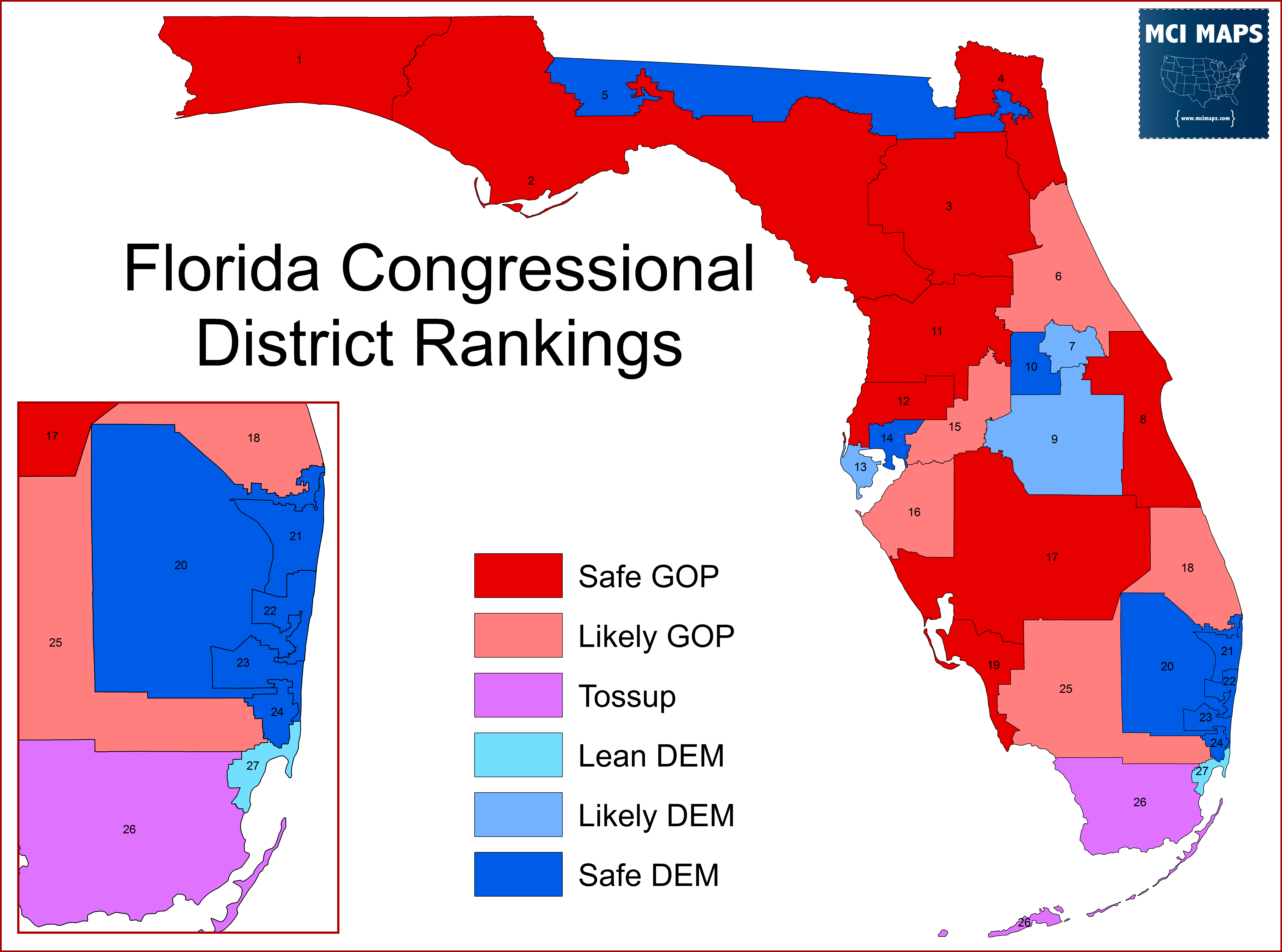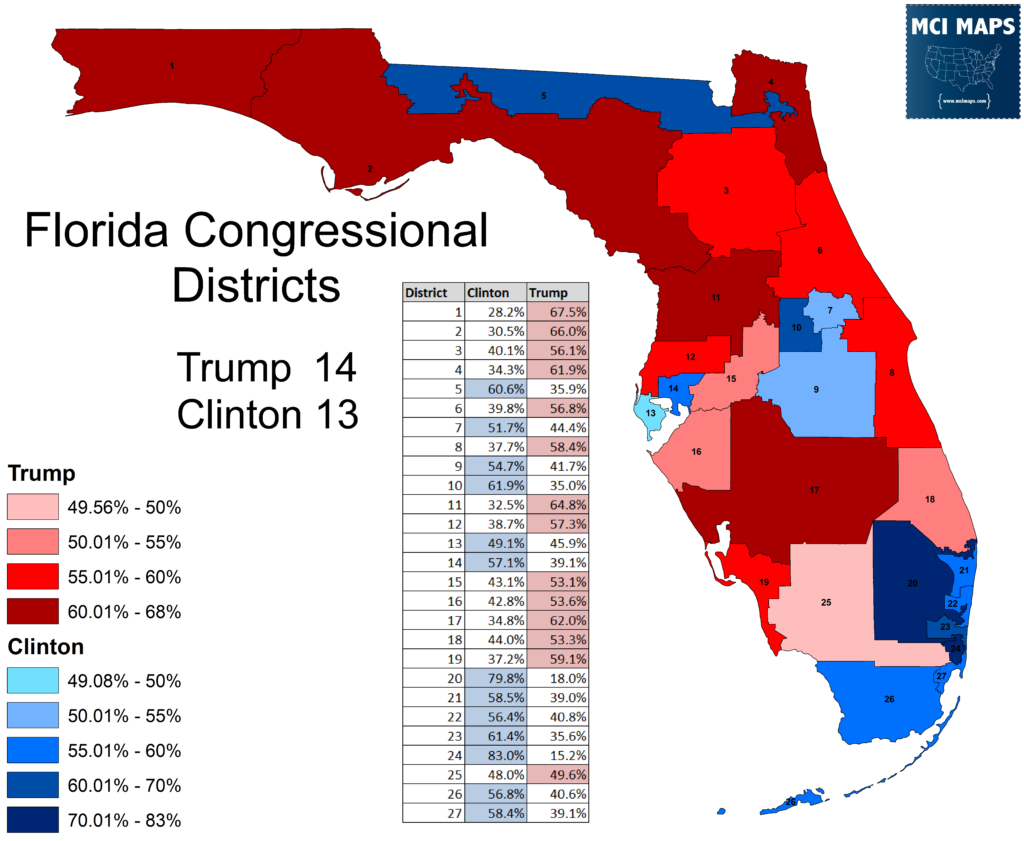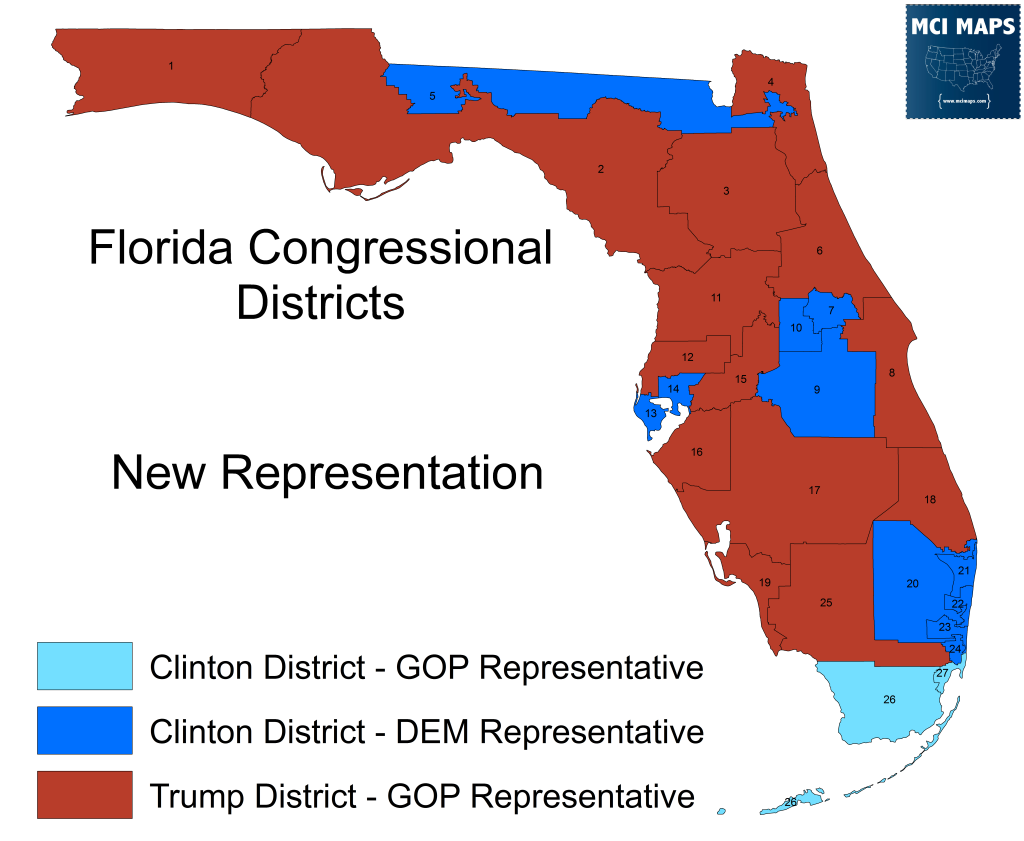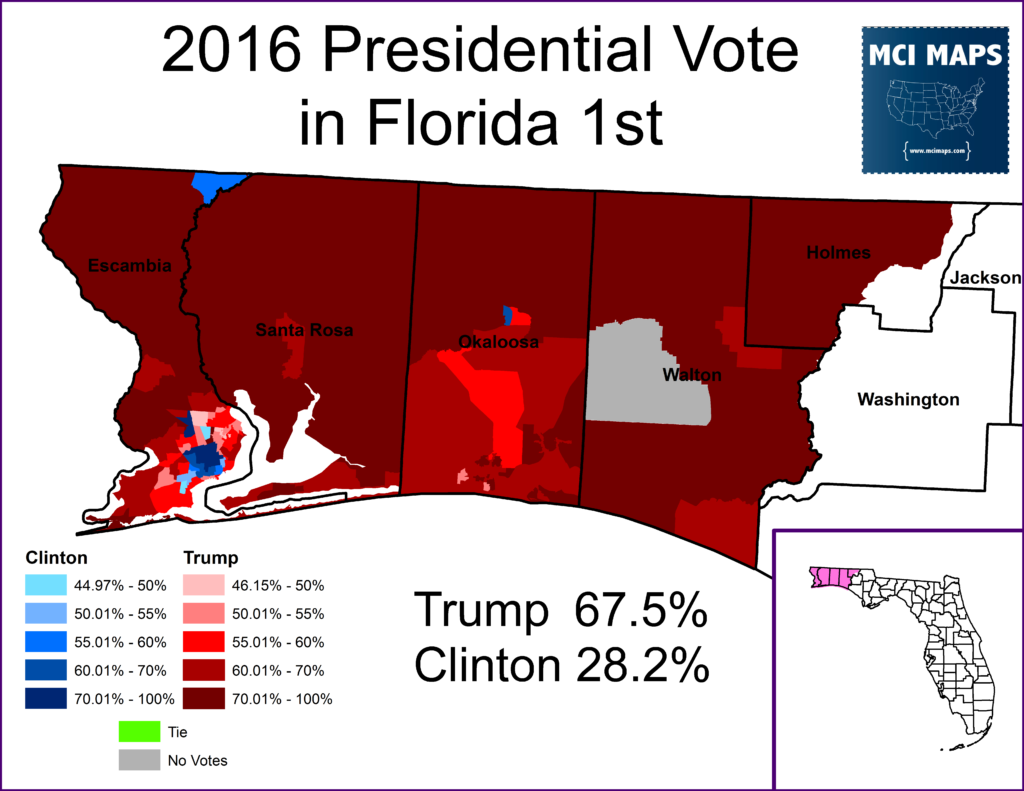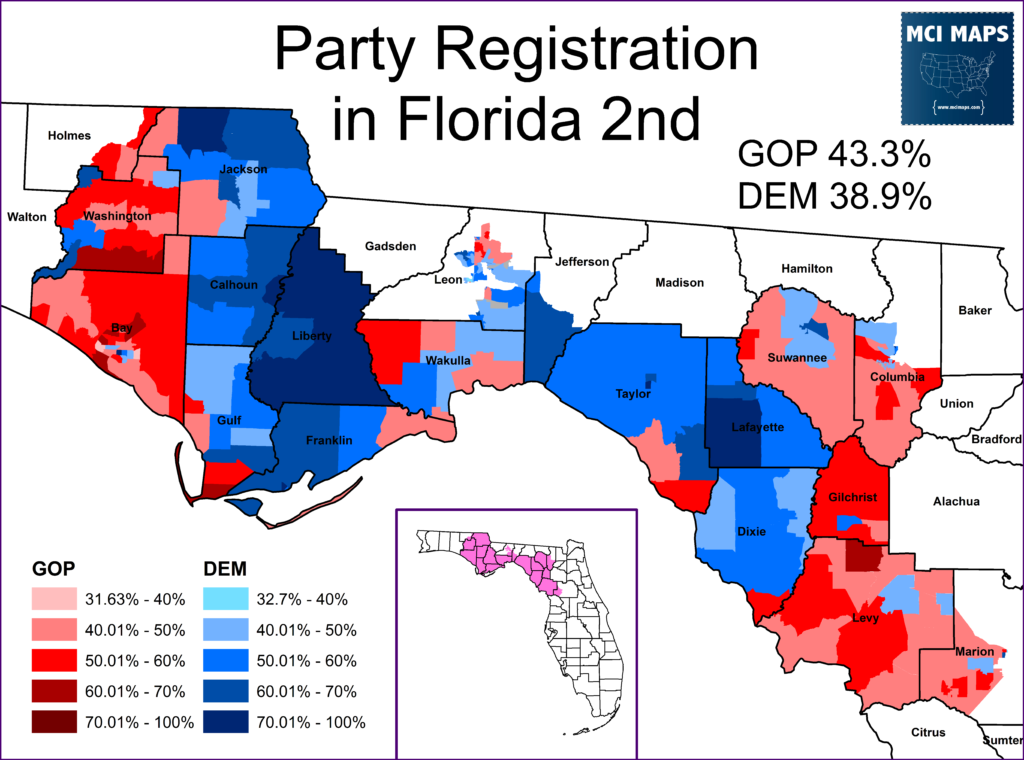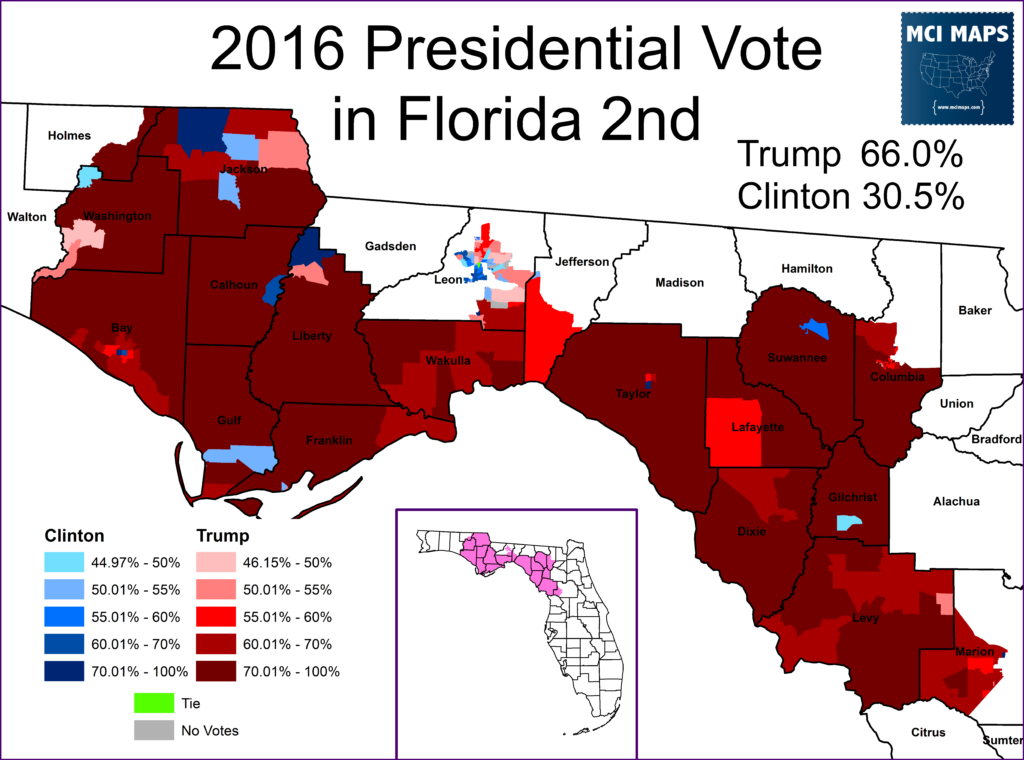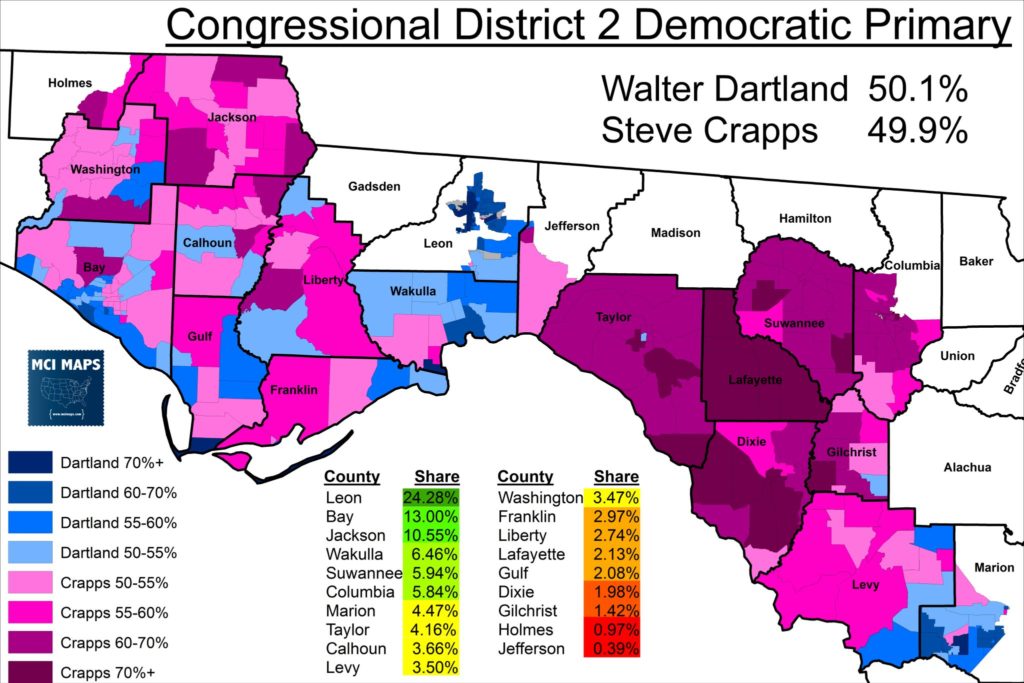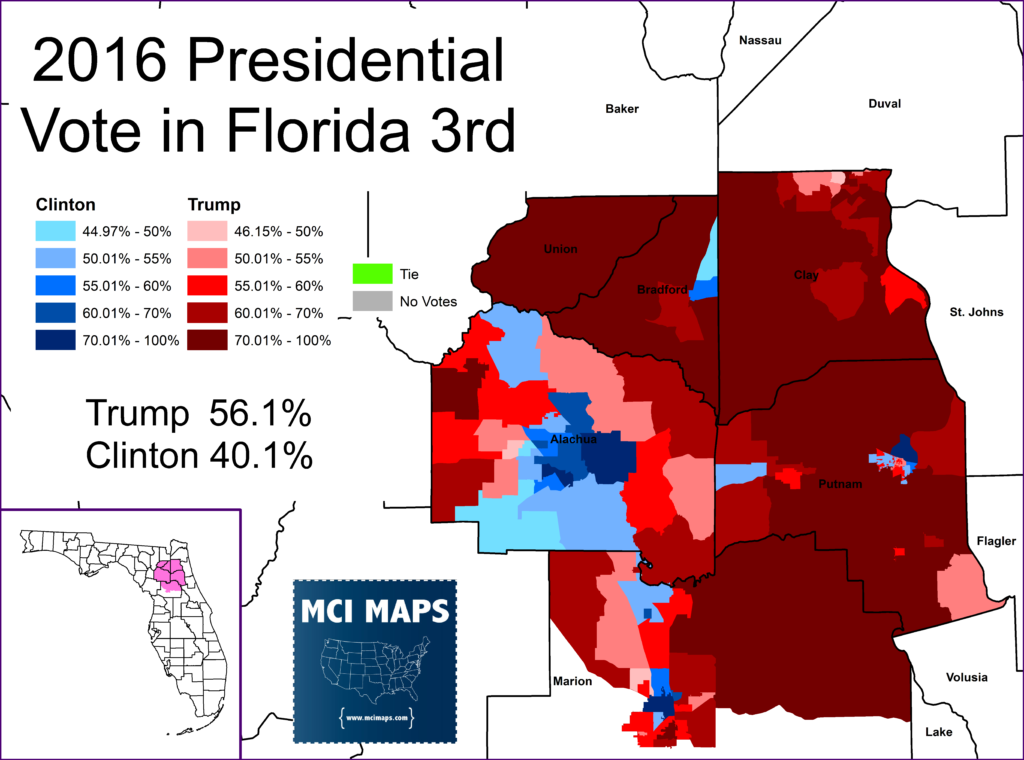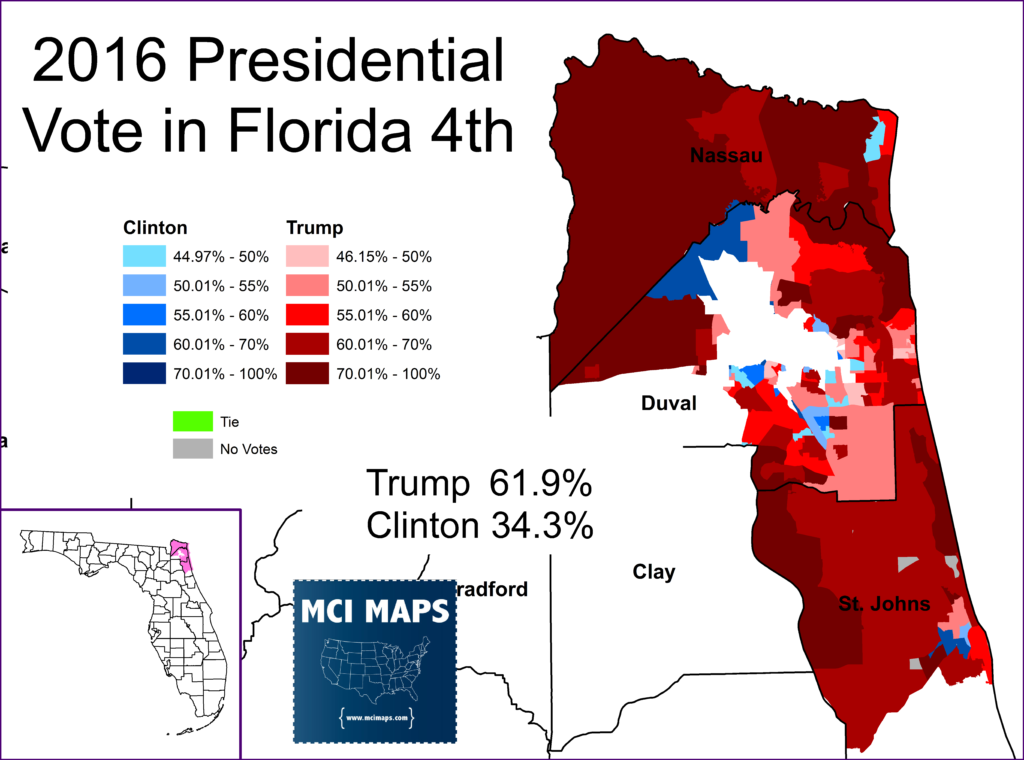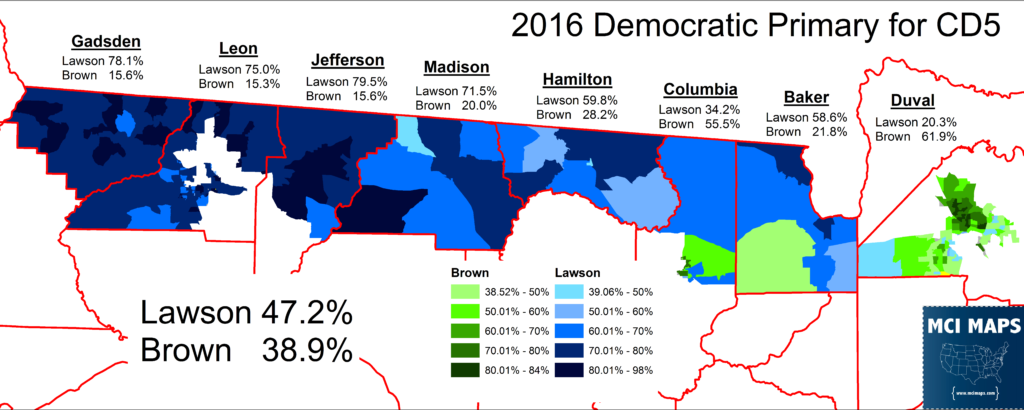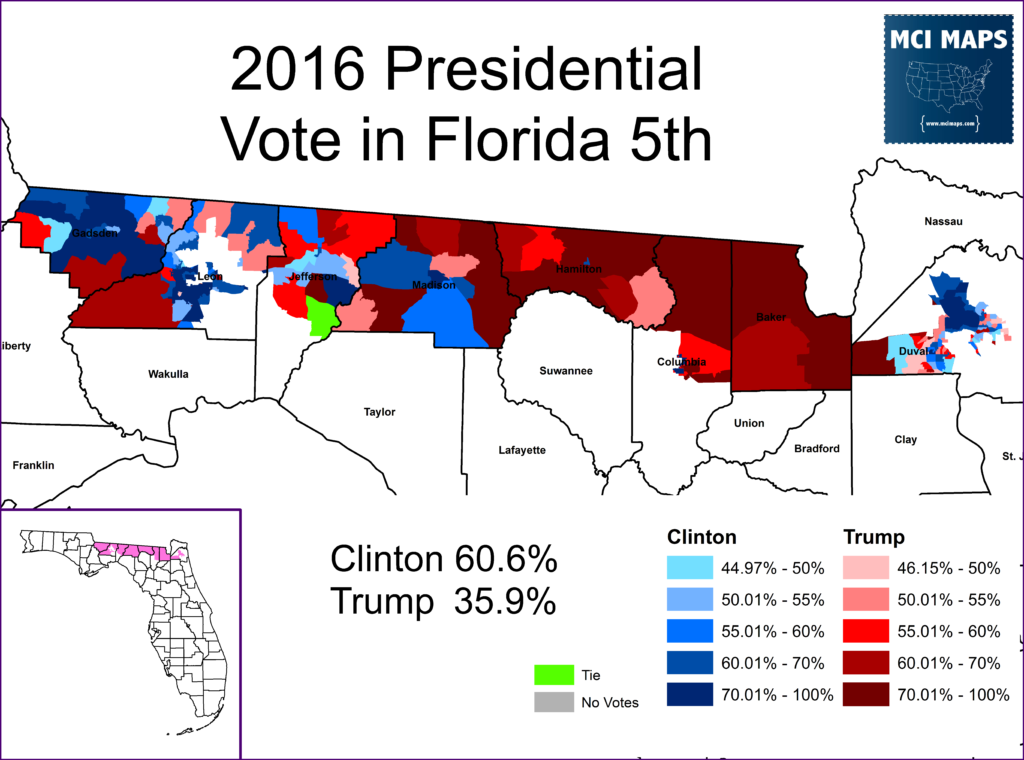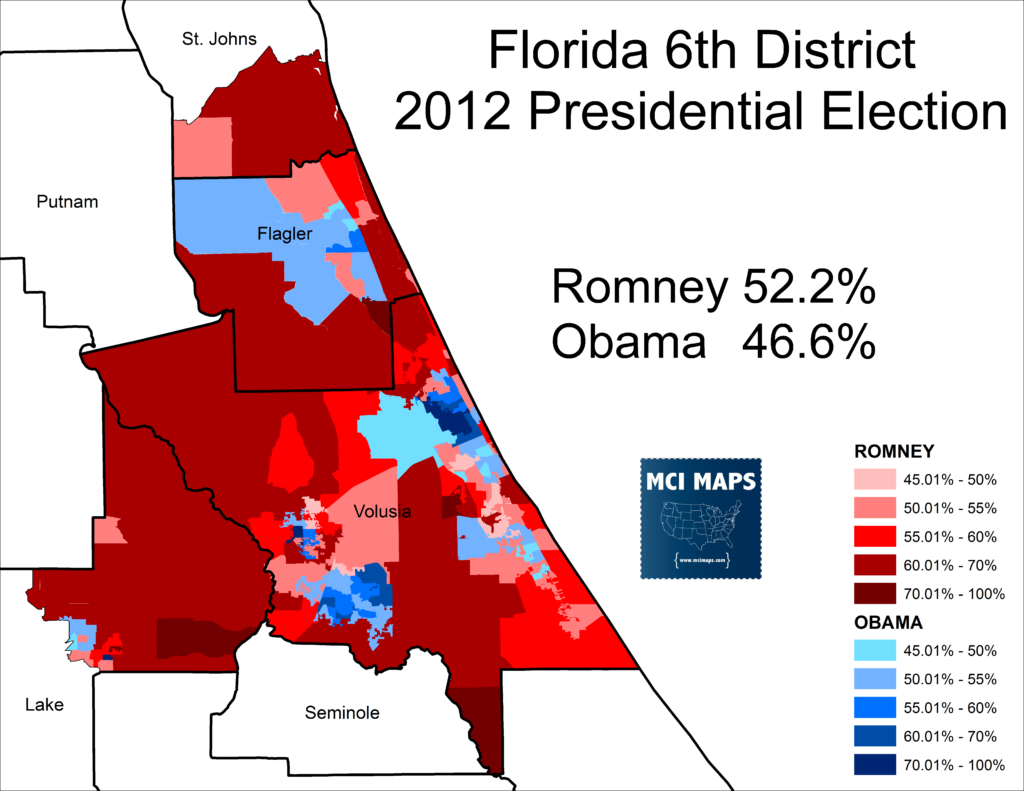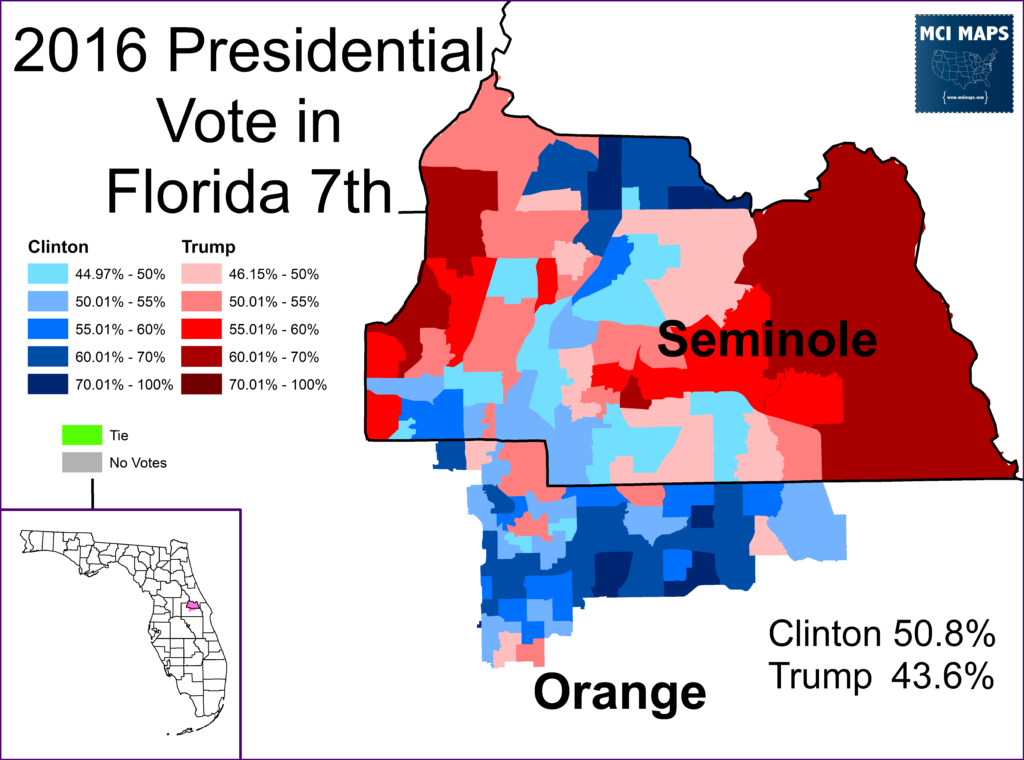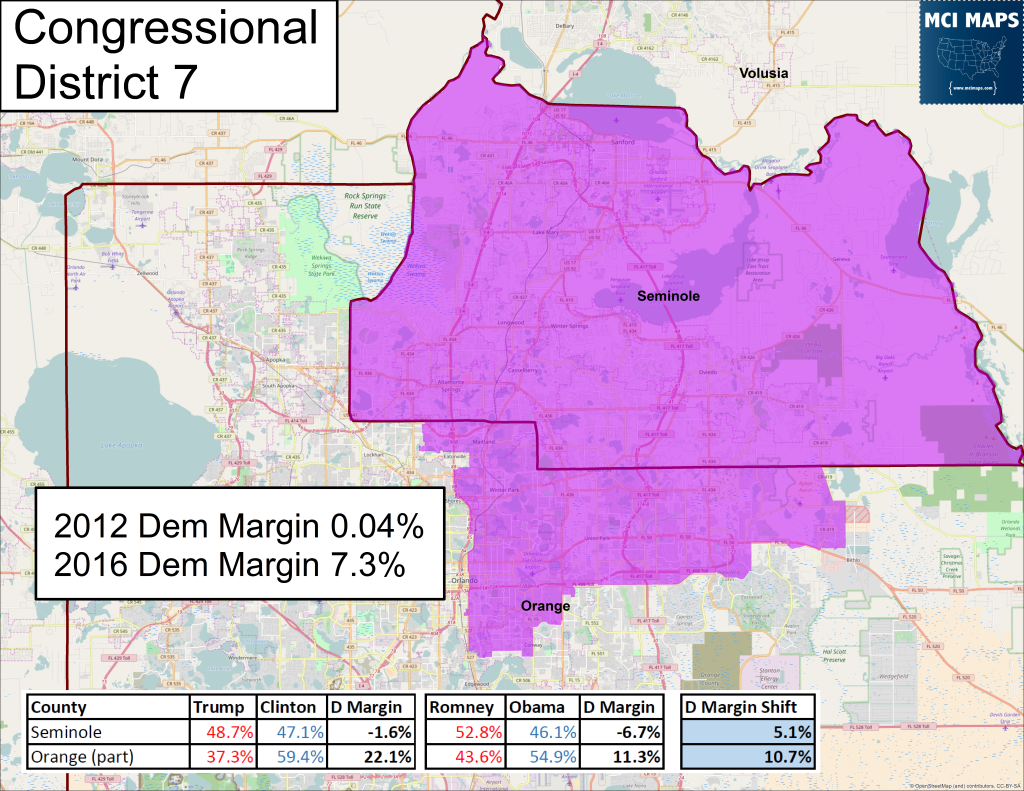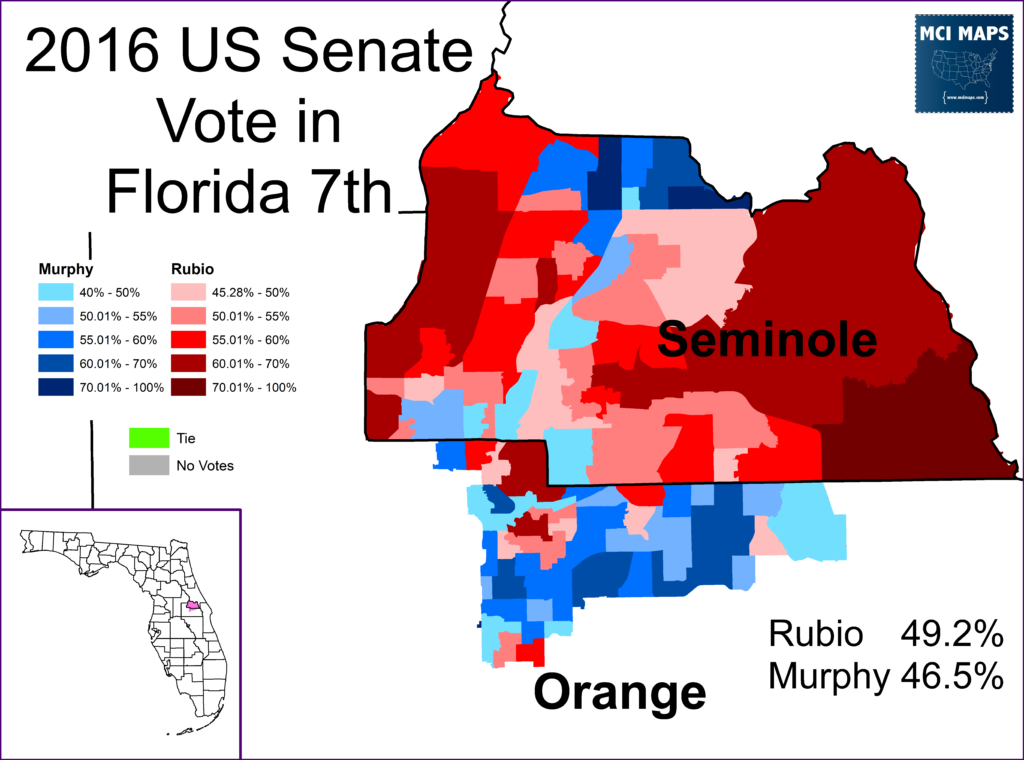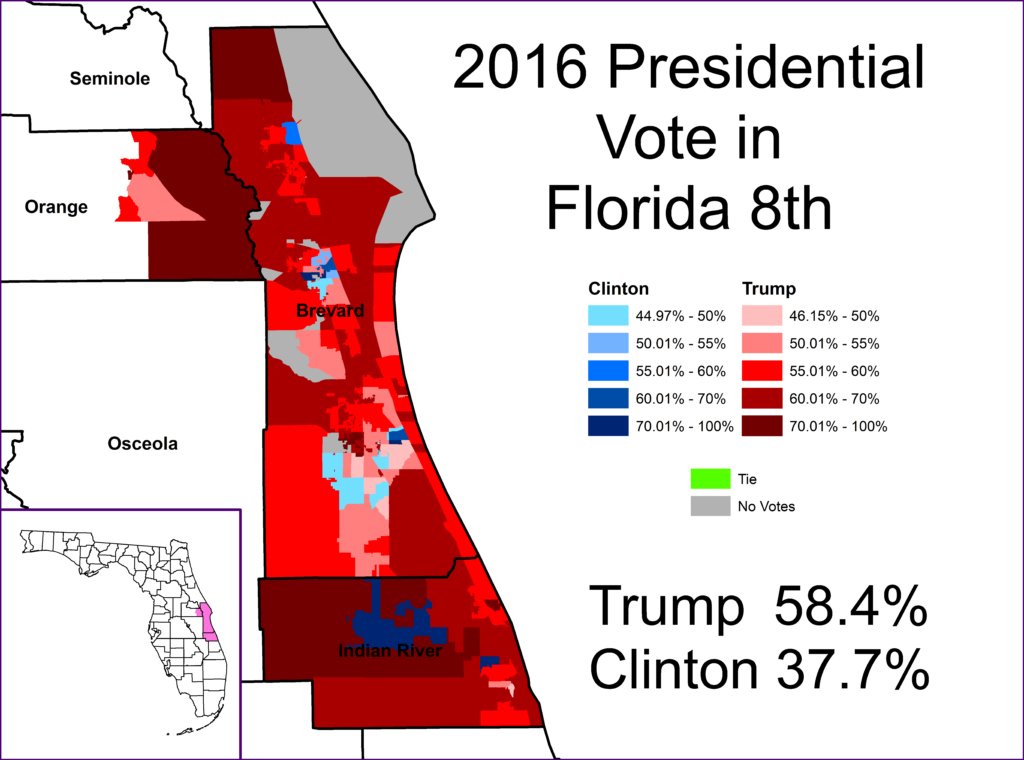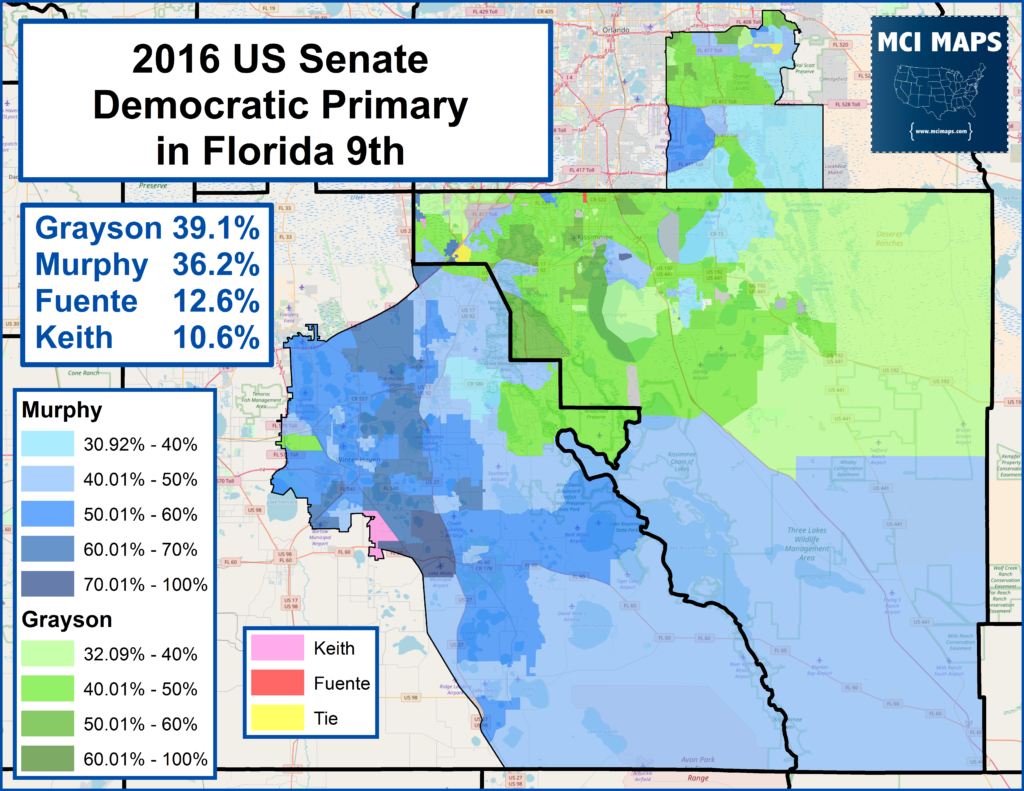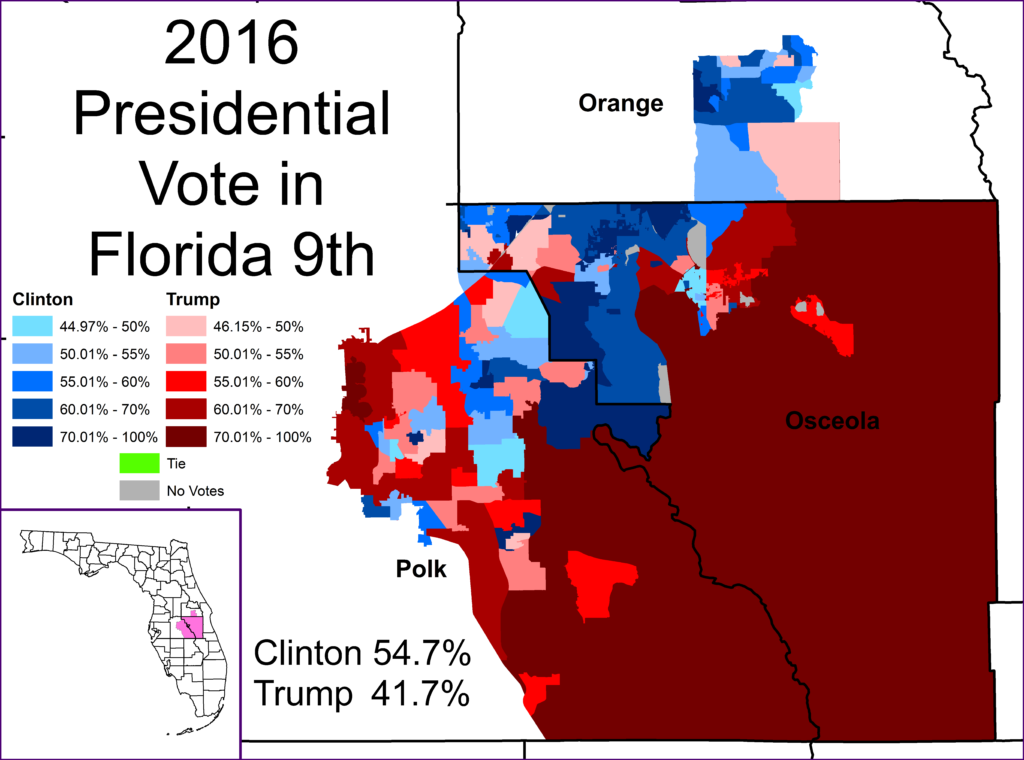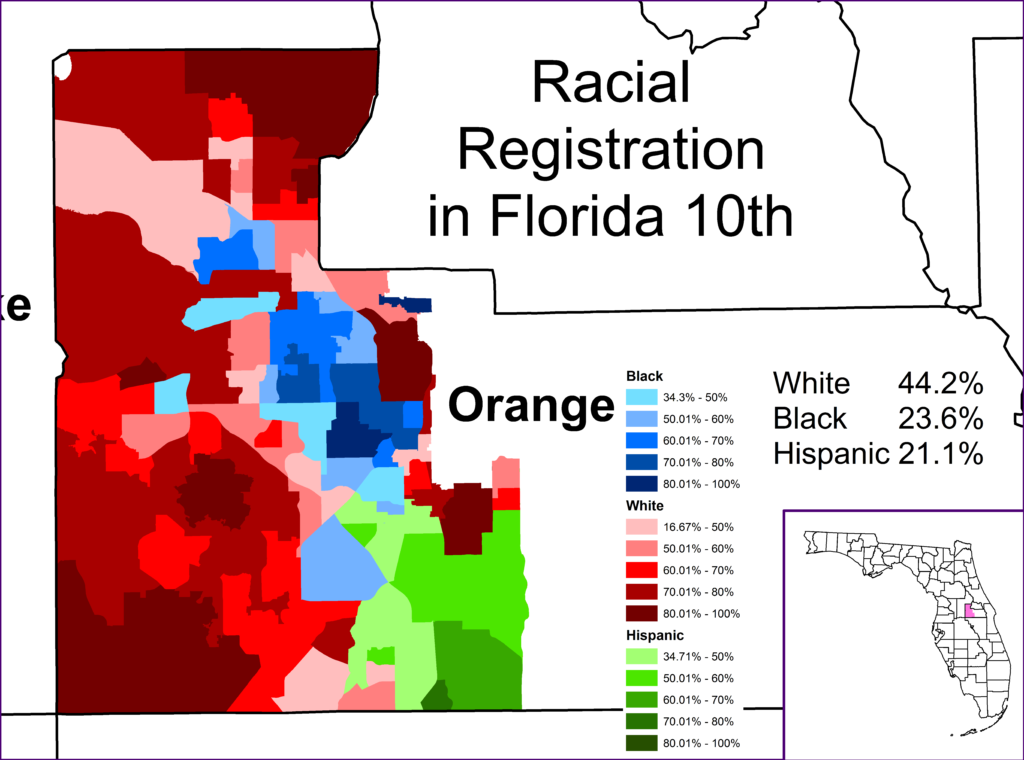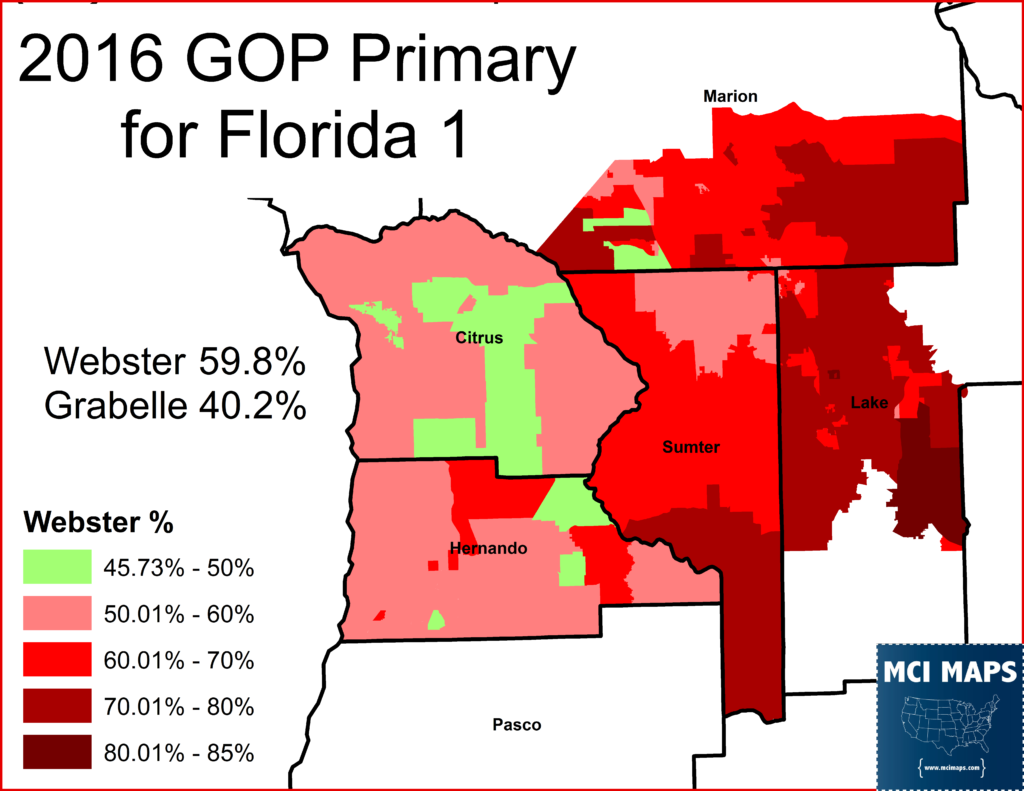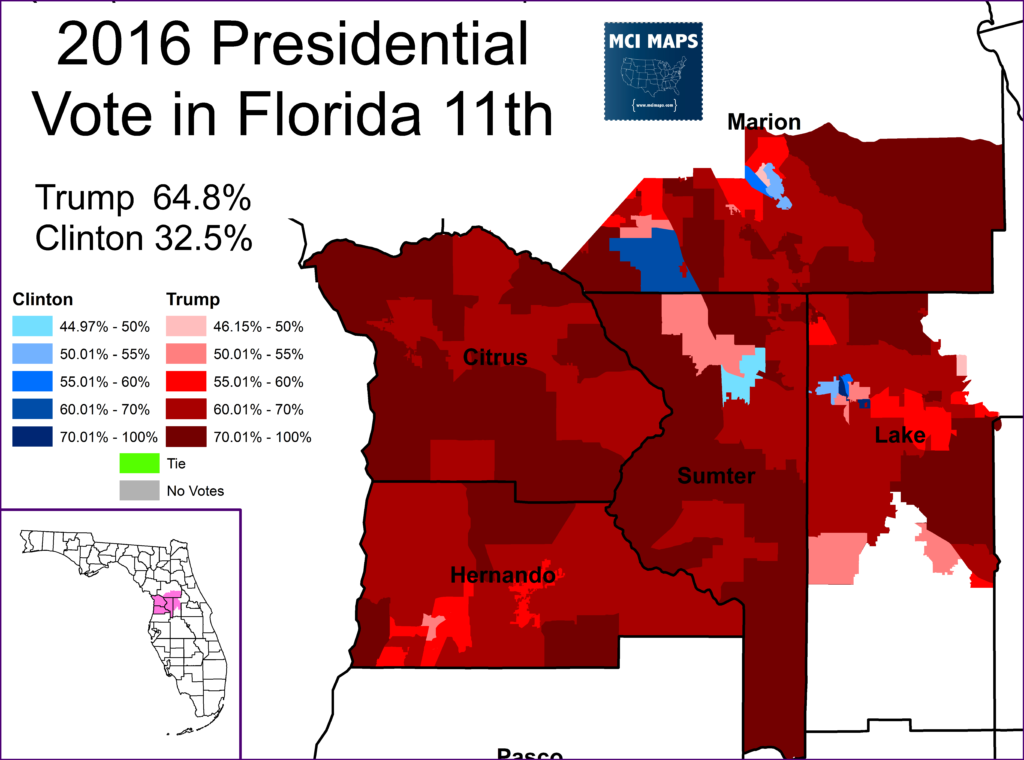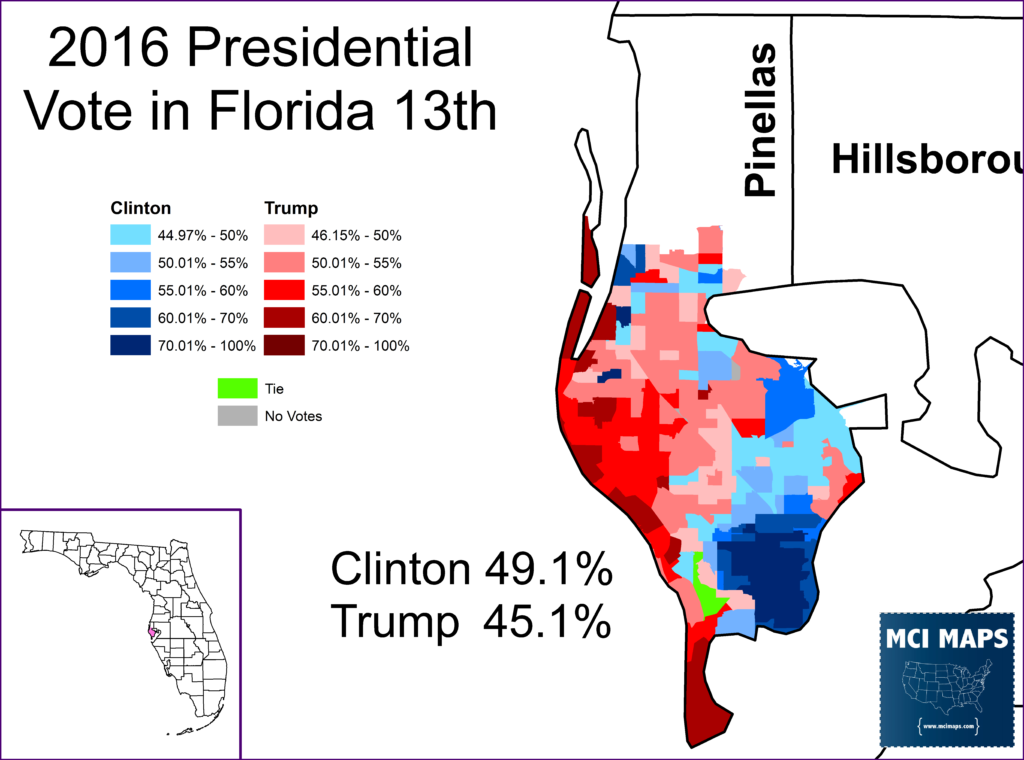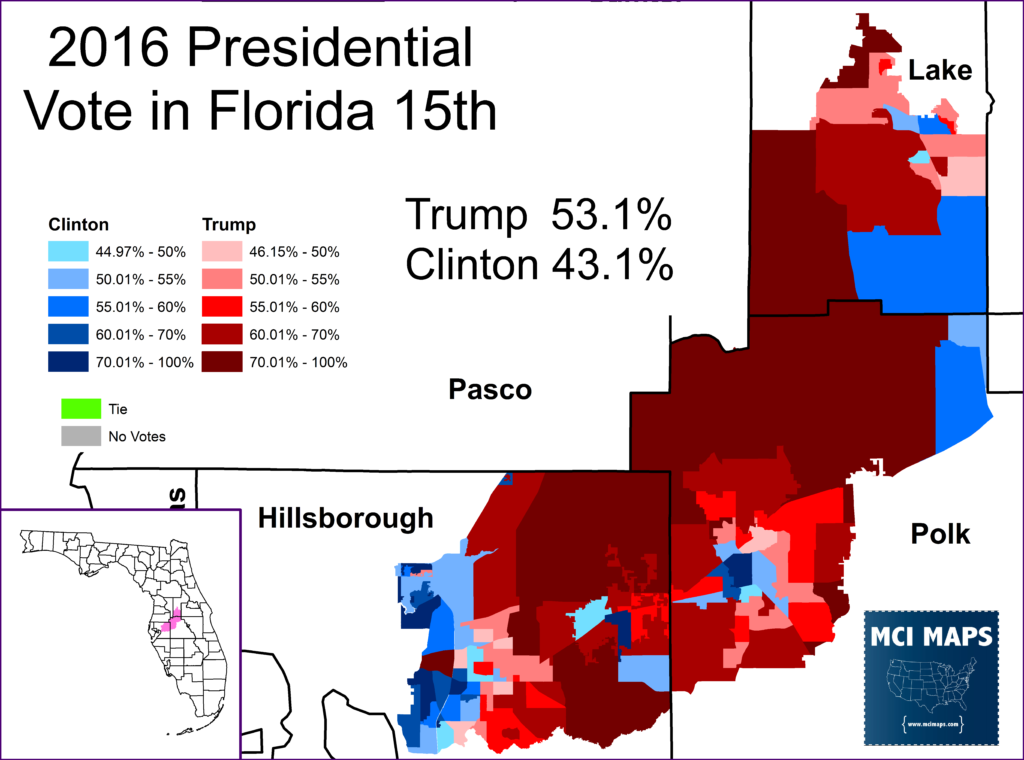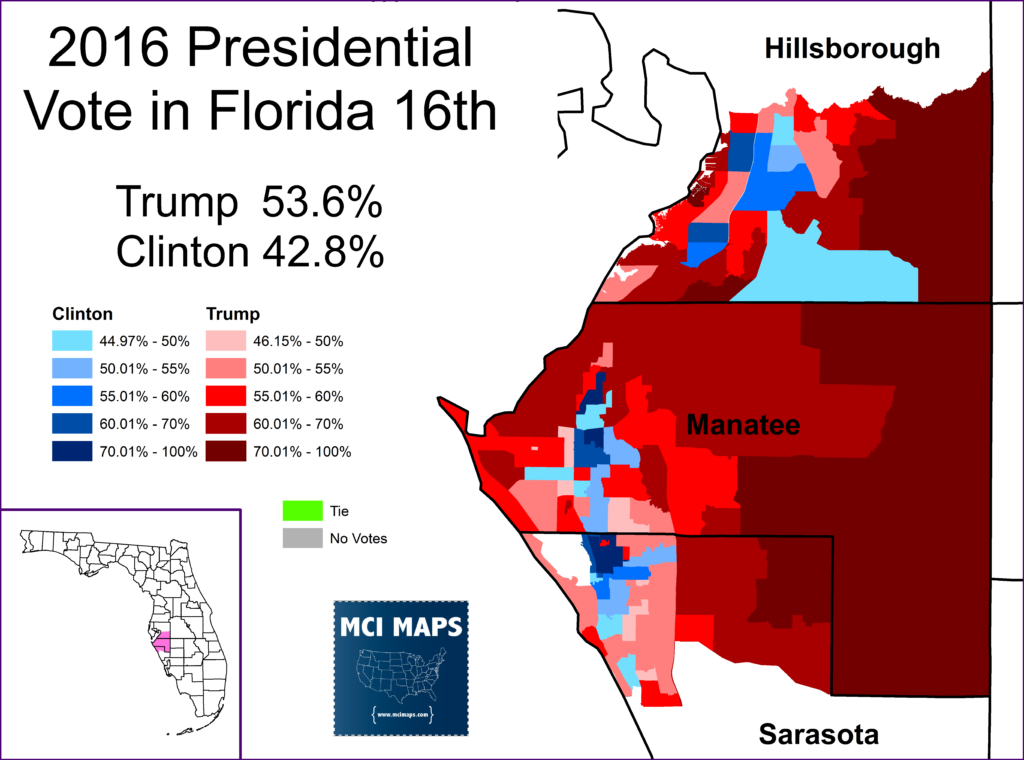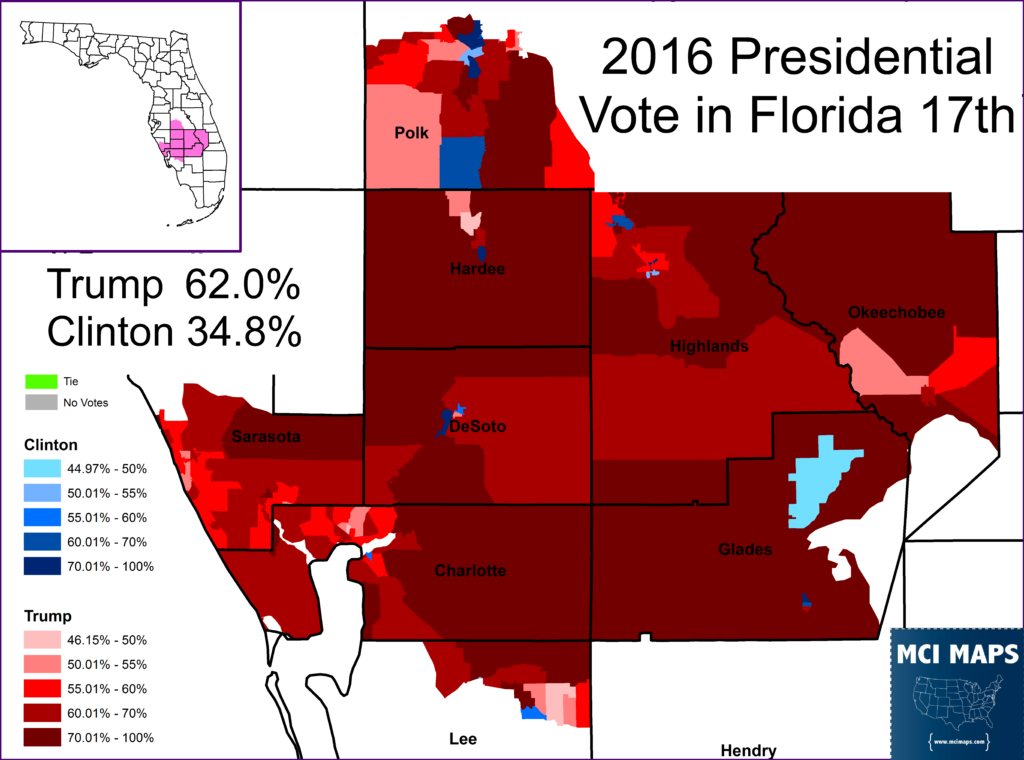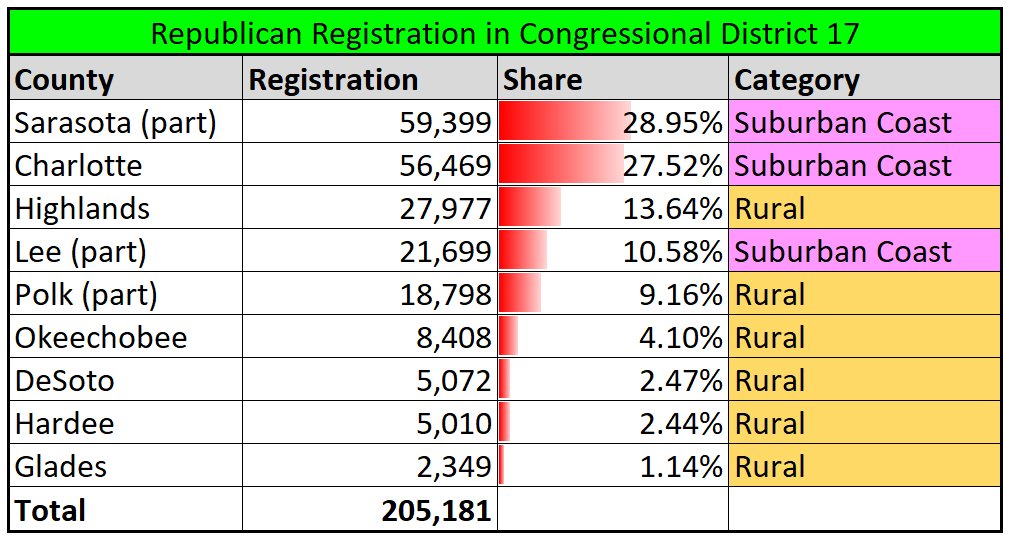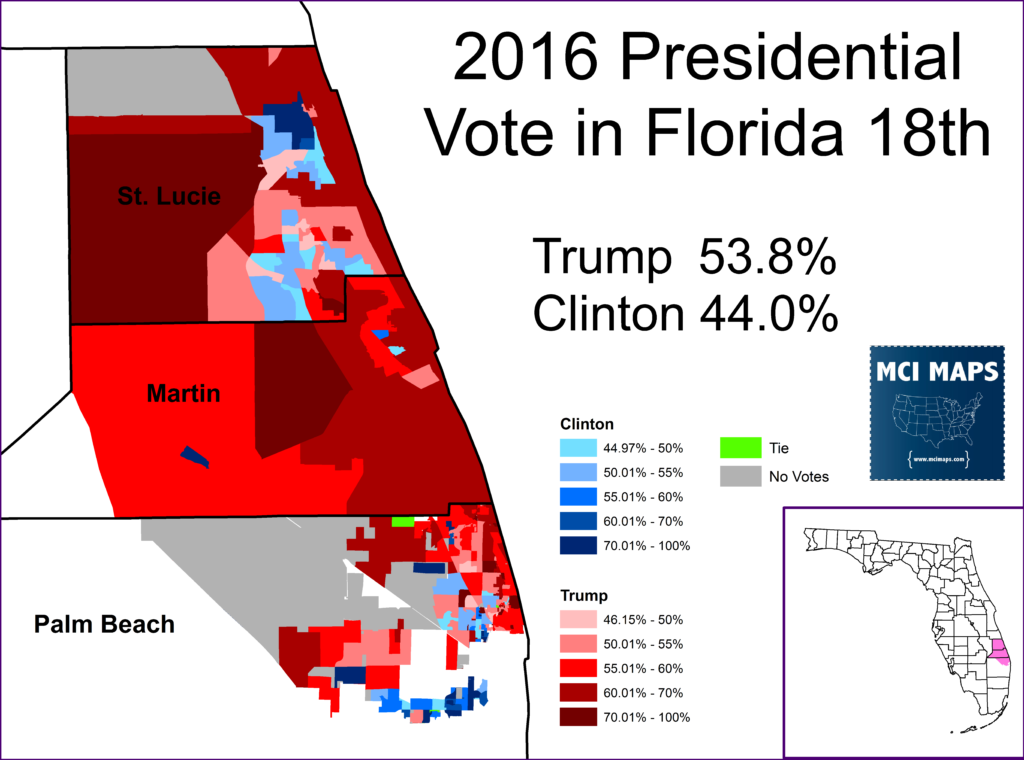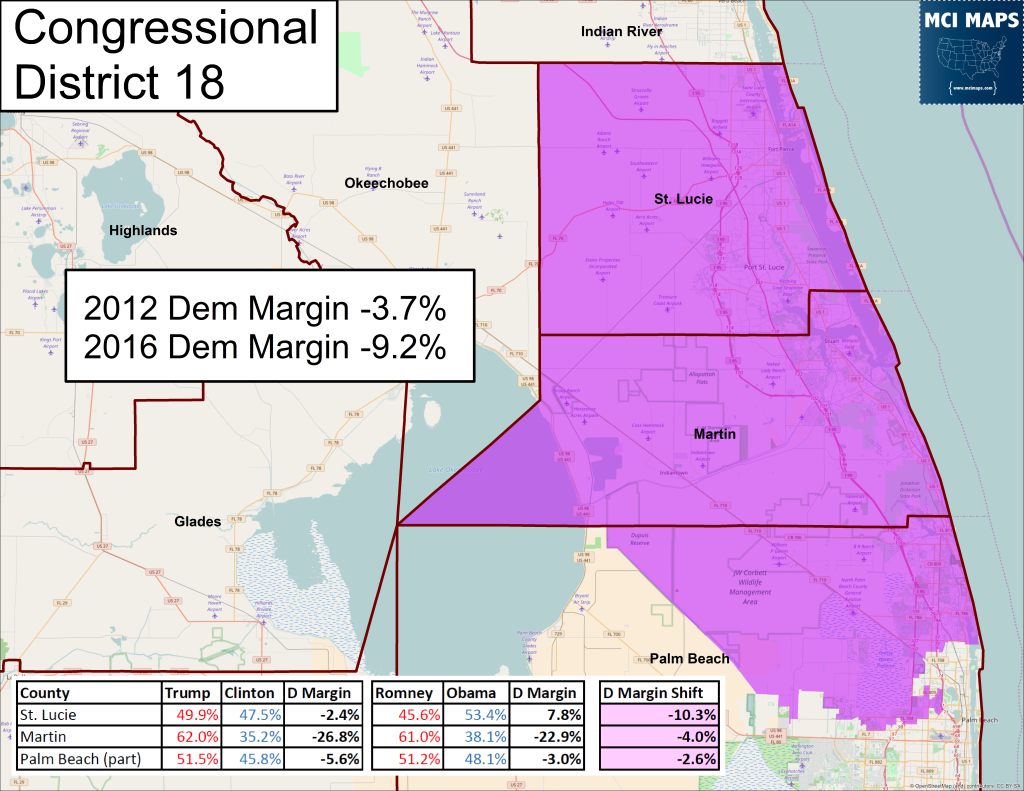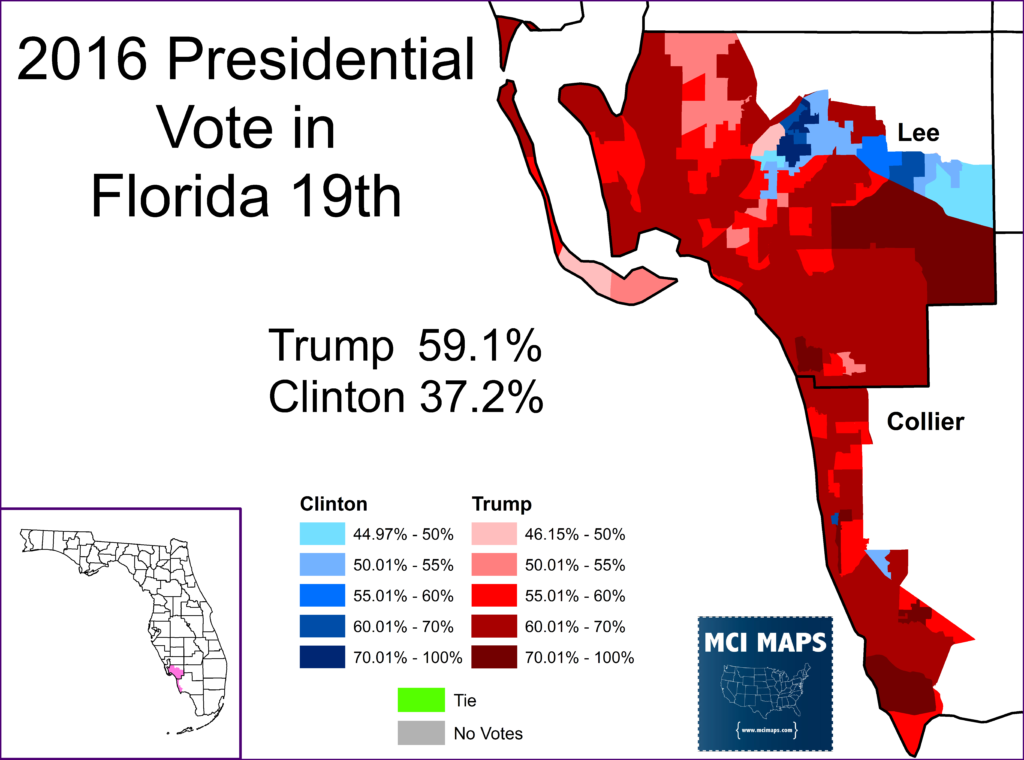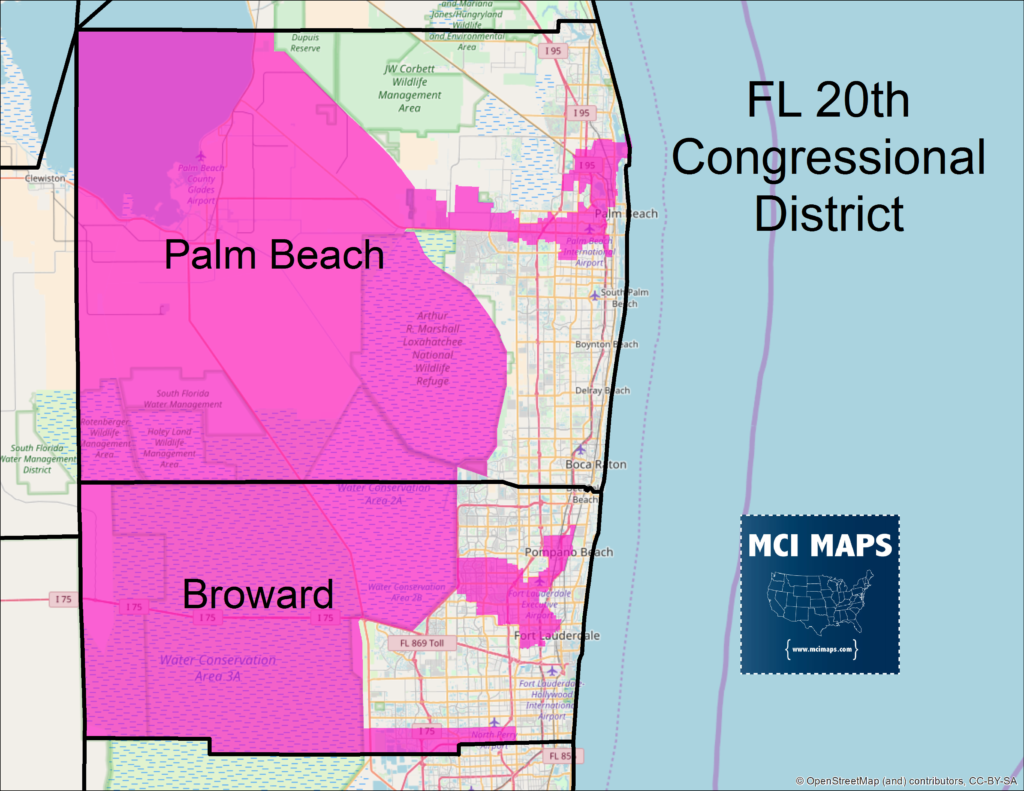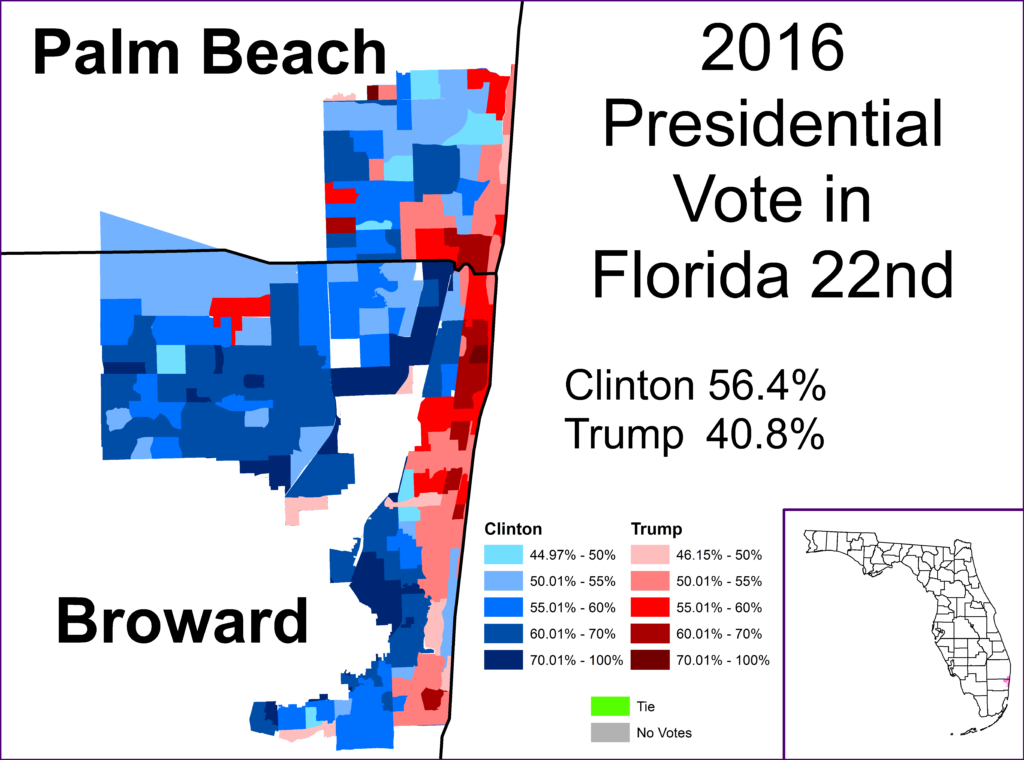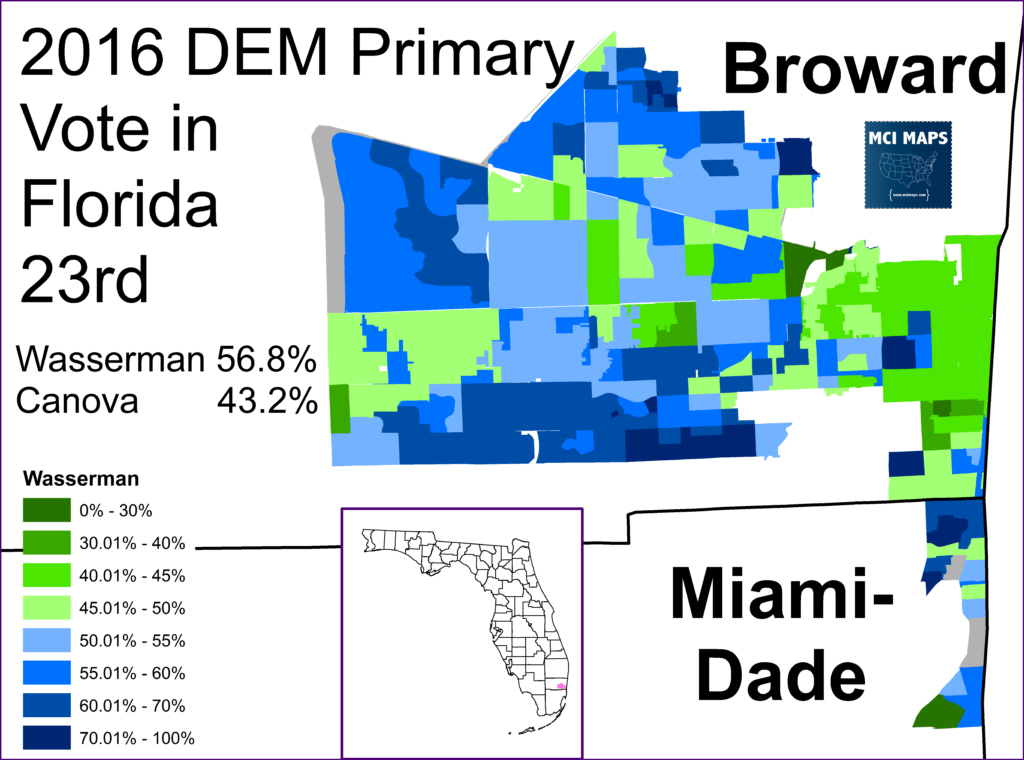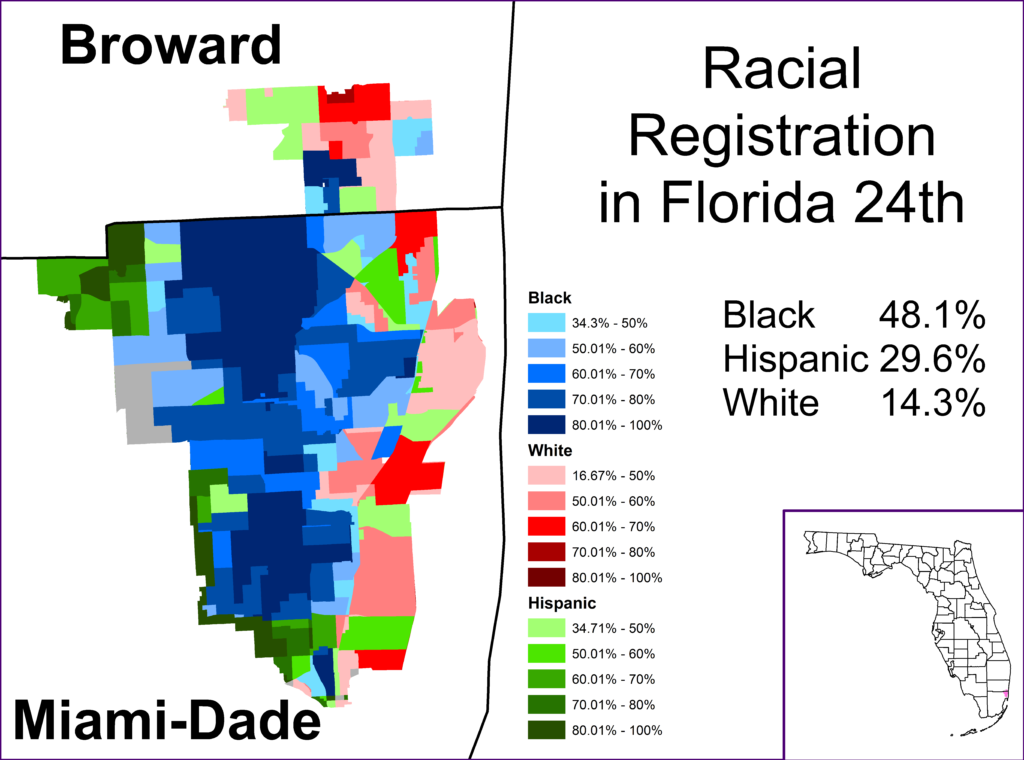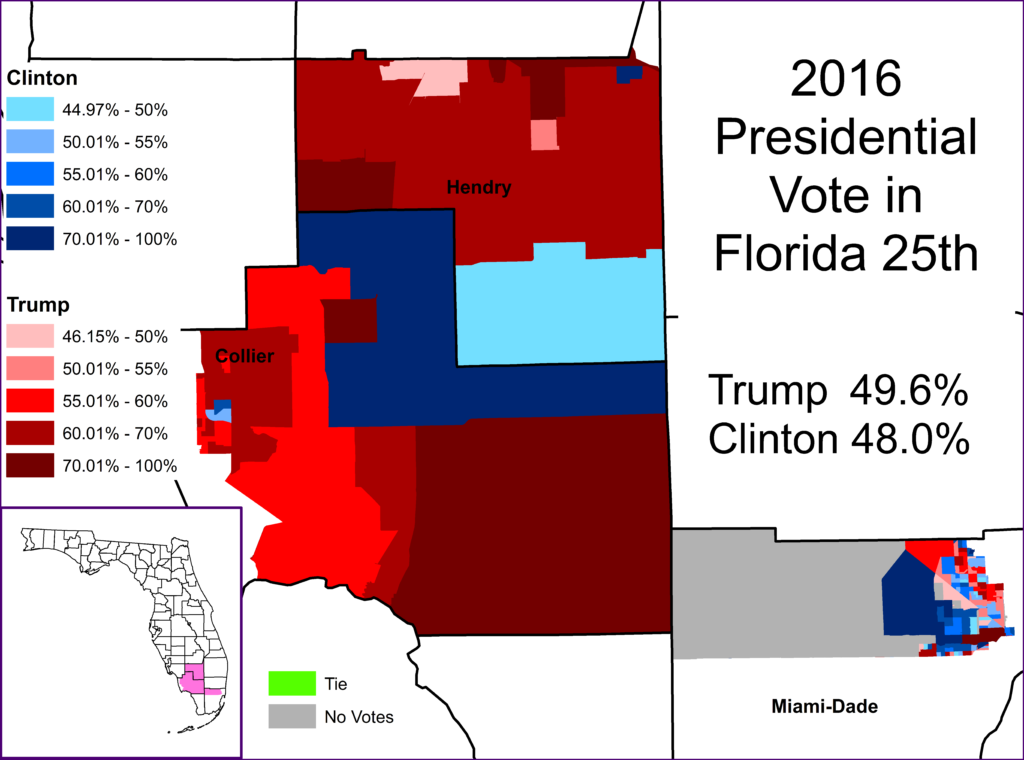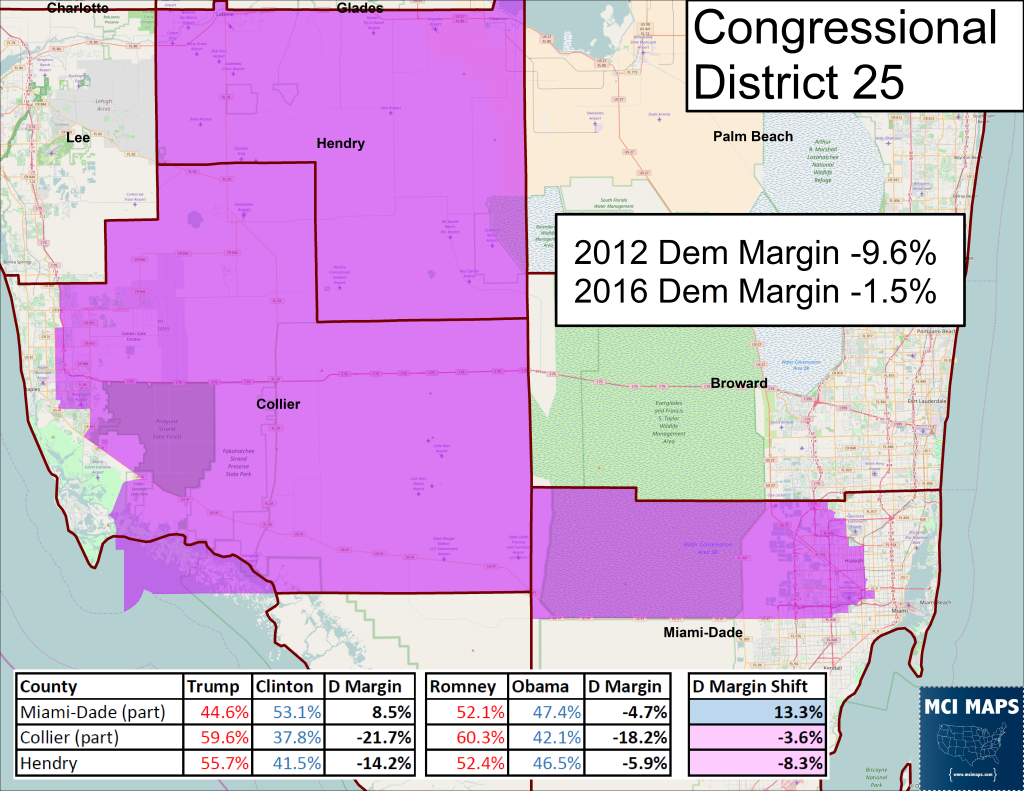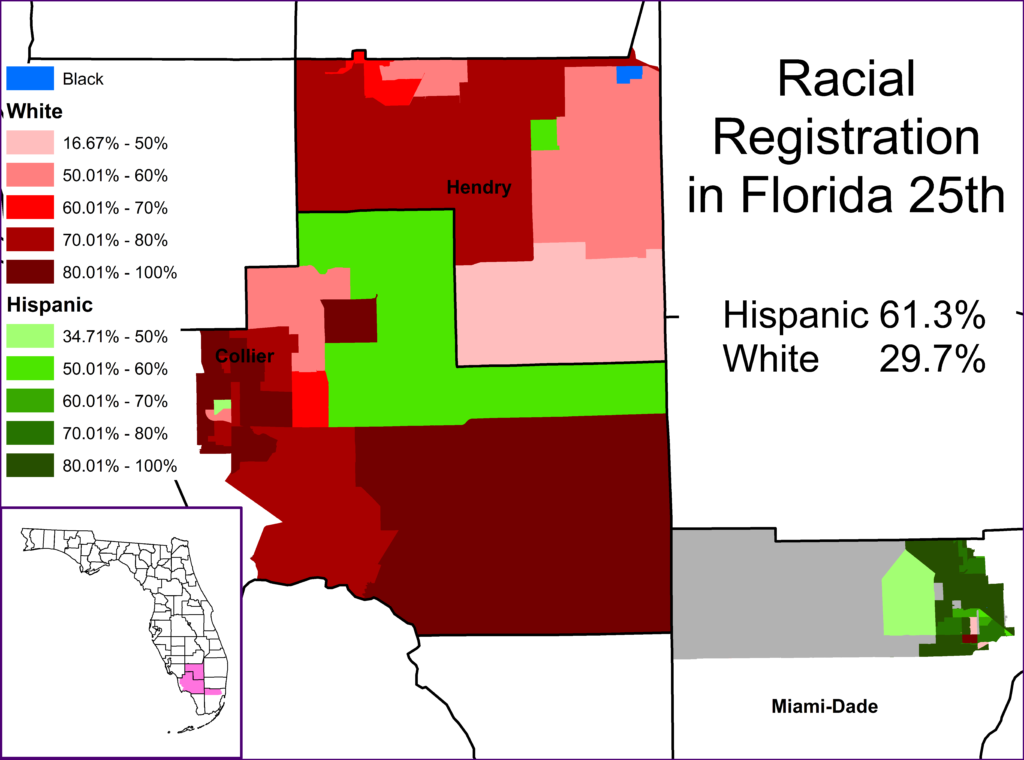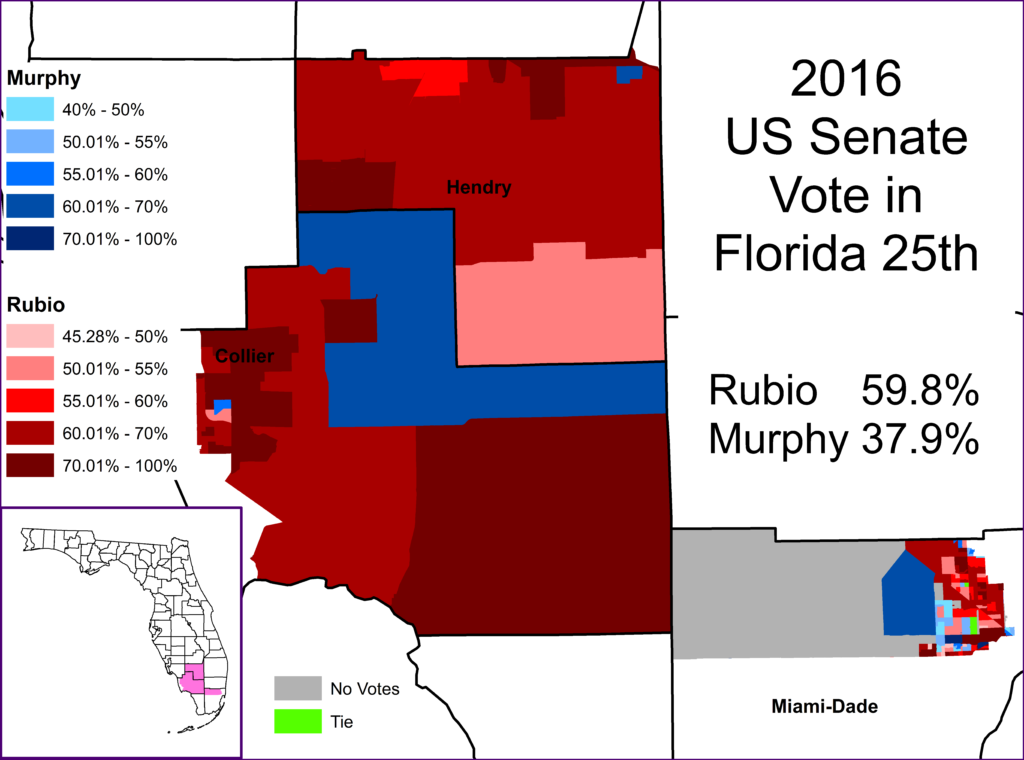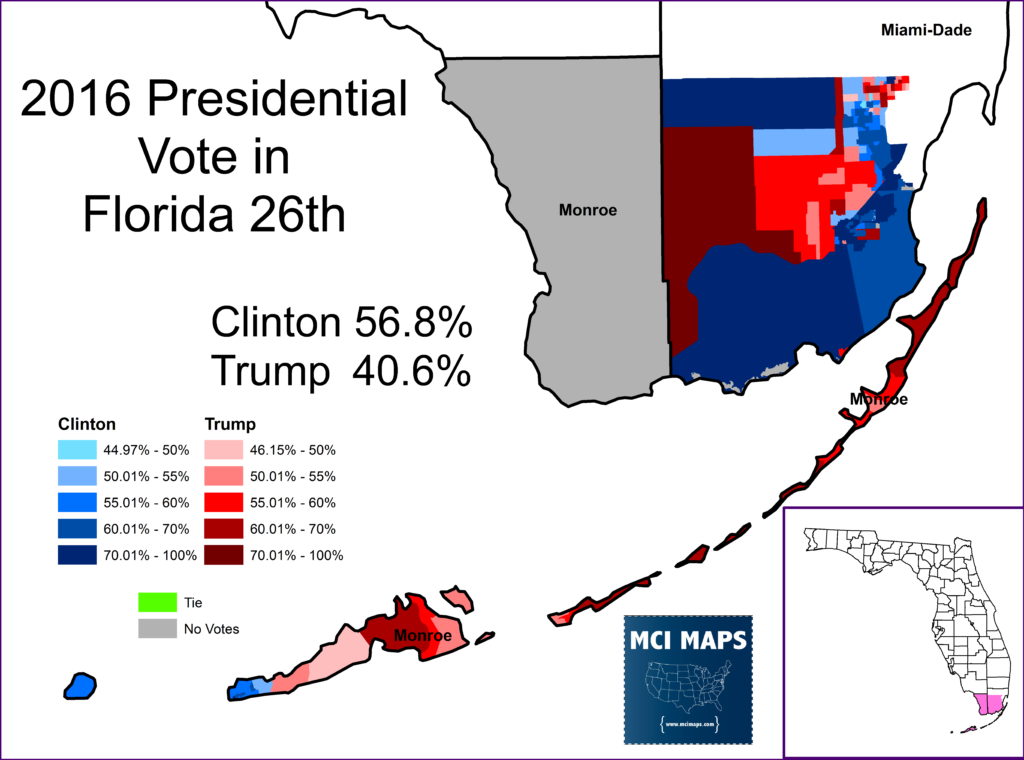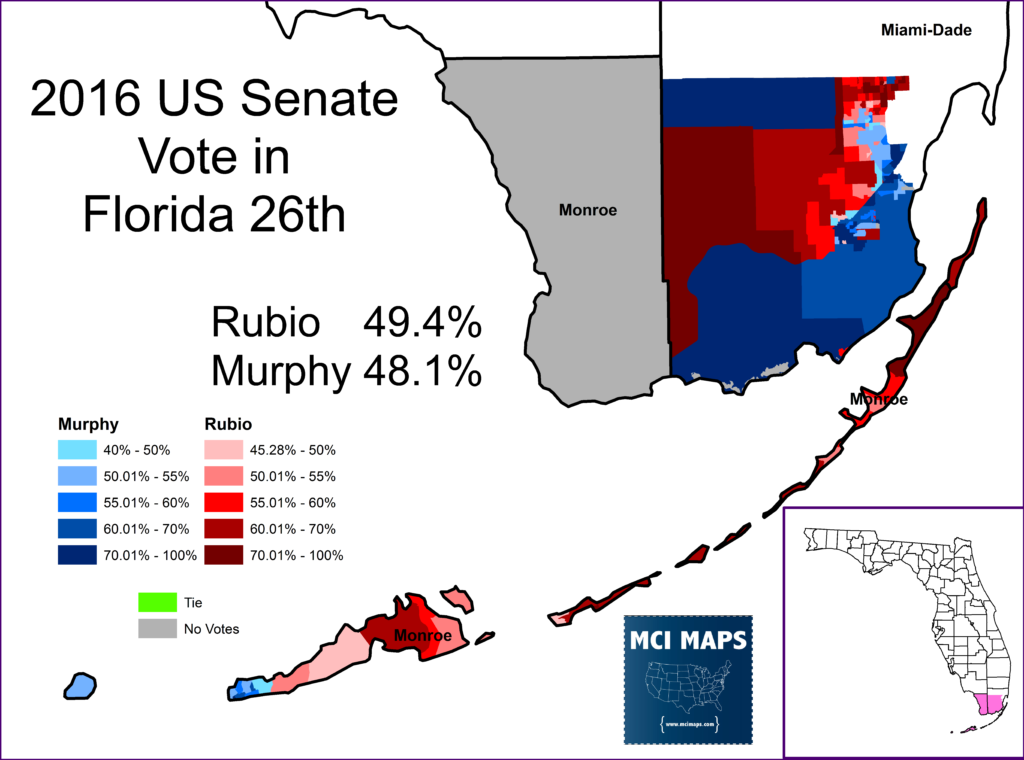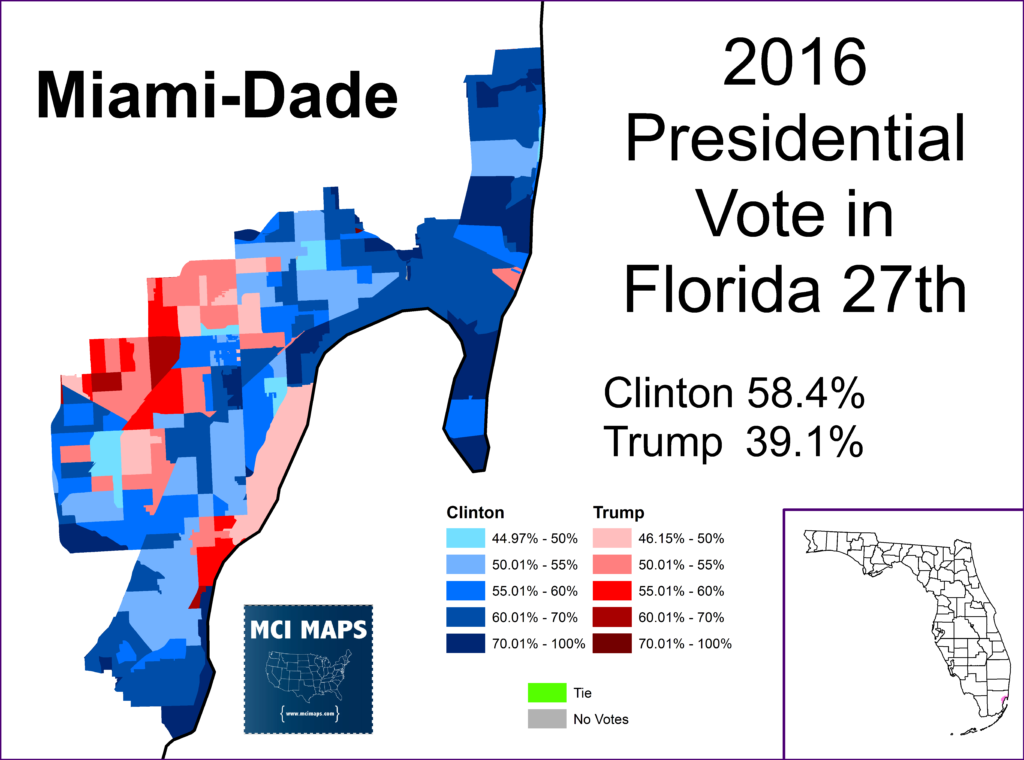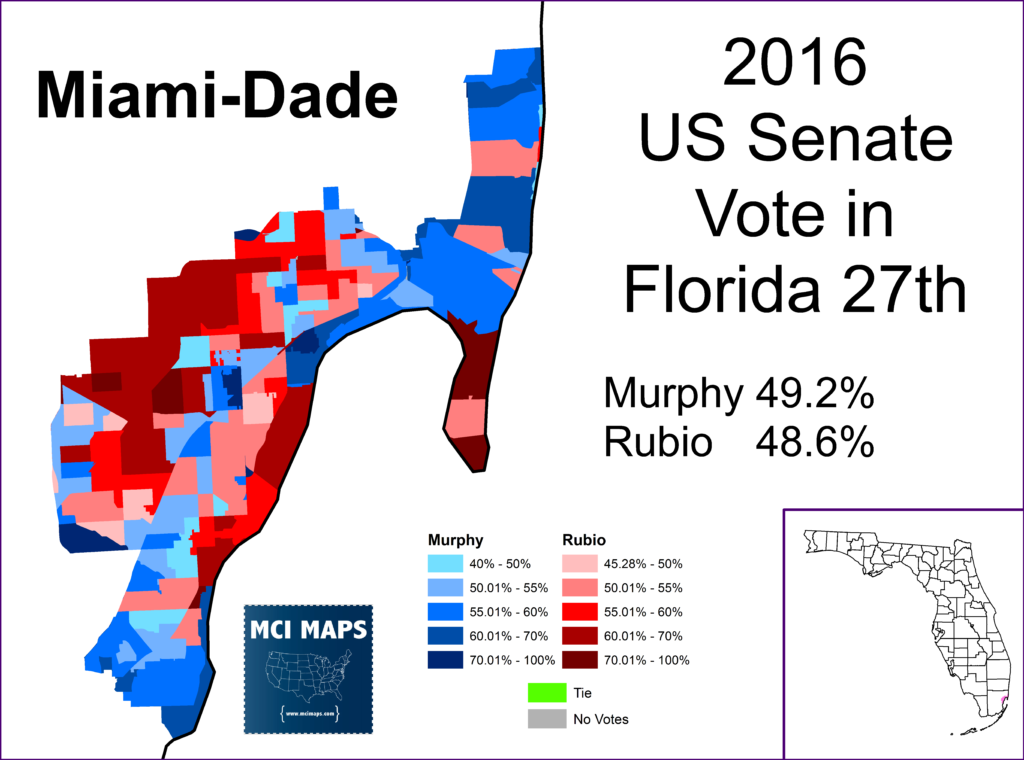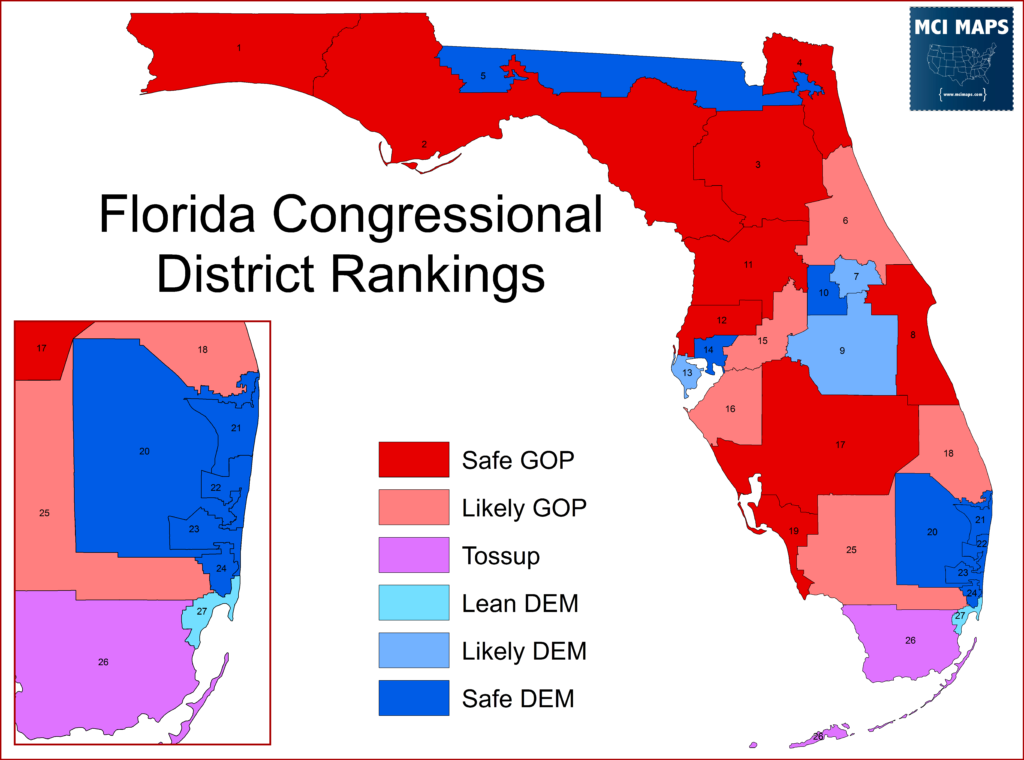Qualifying had ended for Florida’s federal races. Now that we know who is running where, I wanted to do a rundown of the Florida’s districts and see where each falls in the rankings.
Florida’s Current Delegation
Florida’s current districts do well reflecting the statewide vote in the state. This was thanks to mid-decade redistricting that was ordered by the Florida Supreme Court, the GOP gerrymander that previously existed was broken. Under the current map, Donald Trump won 14 districts to Clinton’s 13.
You can read more about how the districts broke down in my article here.
After the 2016 elections, Democrats held 11 districts to the GOP’s 16. Two Clinton districts, Hispanic majority (heavily Cuban) seats based out of Dade, still had GOP Congresspeople.
In addition to looking at how the districts voted; looking at how they voted compared to 2012 is important. Some districts saw Democrats improve, notably those with large non-white populations. Meanwhile, several districts saw huge swings toward Donald Trump.
With federal qualifying done. The chart below shows how many candidates have filed for office. Several congresspeople have decided not to run for re-election.
I’m going to look at each district one-by-one.
Let’s begin.
District 1
It comes as no surprise to people who follow my twitter feed that Matt Gaetz is my least favorite member of Florida’s Congressional delegation. Gaetz was a member of the Florida House, representing coastal Okaloosa County, before he won an open congressional seat in 2016. Gaetz won a multi-way race with 36% of the vote. He’s spent his first term as a feverish Trump supporter, appearing on cable news non-stop. Democrats would love to knock off the obnoxious 35 year old off, but considering the district backed Trump by nearly 40 points, optimism is minimal.
The district’s GOP strength is a combination of military families (its home to one of the largest veteran populations in the nation), rural conservatives, and the Pensacola suburbs. Downtown Pensacola is one of the only Democratic spots in the district. The seat has not backed a Democrat since the 1990s.
Gaetz’s only real threat is a GOP primary. The Congressman’s primary win over State Senator Greg Evers and political newcomer Cris Dosev was not resounding.
Dosev has opted to challenger Gaetz again. He was strongest in the Pensacola suburbs and coastal communities in Santa Rosa and Escambia. Dosev’s campaign, while pro-Trump, is attacking Gaetz for associating with people like Roger Stone and focusing on national fame rather than local issues. Dosev’s problem is that its not clear Evers voters, which came from rural conservatives, would go to Dosev over Gaetz. A third GOP candidate, John Mills, who hails from a military background, is also running. What his support will be remains to be seen. For now, Gaetz has a clear primary path to victory.
As for the general election: Safe Republican
District 2
Republican Congressman Neal Dunn is is running for re-election in the 2nd district. The Congressman won the open seat after 2015’s mid-decade redistricting changed the lines. Like District 1, the 2nd congressional district is a solid GOP seat that is unlikely to turn blue. The district is made up of ancestral Democratic rural counties as well as white Leon County suburbs. The Leon/Tallahassee portion of the district is the only swingish part of the district. Many of the rural counties are still Democratic down-ballot (county commission, sheriff, so on) despite years of voting GOP for Governor and President. Registration between the two parties is actually close but the GOP took the lead recently and its unlikely to reverse.
At this point, longtime local Democratic office-holders are trying to hold on to their offices. Hopes for winning the congressional seat are minimal. Trump won the district by 36 points.
Democrats actually have a primary for their nomination. It will feature former Leon Commissioner Bob Rackleff against Levy County resident Brandon Peters. This will basically feature a suburban Democrat against a rural Democrat. A similar dynamic played out in 2016 when Leon-based Walter Dartland narrowly edge Suwannee-based Steve Crapps.
The winner of the primary will be a major underdog against Dunn in the fall. Baring massive scandal, its hard to see this seat slipping away.
Current Ranking: Safe Republican
District 3
Congressman Ted Yoho was a surprising congressman. He defeated longtime incumbent Cliff Stearns in 2012. Stearns had seen his district drastically reshaped in redistricting and wound up with a large chunk of new voters. On top of that, he found himself in a heated race with State Senator Steve Oelrich. The two establishment Republicans brutalized each-other, allowing veterinarian Ted Yoho to pull off a win with rural support. Yoho has since had little struggle winning election while maintaining a strong freedom caucus record. His new district remains solidly GOP.
Democrats have a base in Alachua County, home to Gainesville and University of Florida. However, the rest of the district includes rural voters as well as deep-red Clay County; home to Jacksonville suburbs.
Yoho has a Republican primary challenger, Judson Sapp, who is running on a platform against the partisanship of congress. Its not clear his primary can gains steam, though it could play well with suburban Republicans in Clay (who didn’t support Yoho in 2012). Yoho has lost much of the rural areas that backed him in 2012.
Right now it seems clear Yoho is the favorite in the primary. He’d probably be more vulnerable to a more well-known Republican from Clay or Alachua, rather than a newcomer. He will face one of three democrats vying for the nomination. The strongest is likely Yvonne Hayes Hinson, a former Gainesville city commissioner.
Current Ranking: Safe Republican
District 4
Former Jacksonville Sheriff John Rutherford was elected to the 4th district when it became open in 2016. He faces no primary opponent and is heavily favored in one of the deepest red districts in the state. The seat is based out of Nassau county, the conservative white suburbs of Jacksonville, and the conservative wealthy communities of St Johns.
Democrats got one candidate, George Selmont, a St Johns attorney, to file. A few other NPA candidates and write-ins have filed as well. This will be the most boring race in the state.
Current Ranking: Safe Republican
District 5
Disclaimer: I am supporting and working with Al Lawson.
The new version of the 5th district was created in 2016 and is meant to be a minority-access seat. It connects African-American populations across North Florida, stretching from the Tallahassee market to Jacksonville. District 5 will feature a major Democratic primary. Congressman Al Lawson, elected to the newly-formed 5th district in 2016, will face off with former Jacksonville Mayor Alvin Brown. Lawson is based out of Tallahassee, making the race a fight between the Tallahassee and Jacksonville markets. The two metro zones make up the bulk of the districts population, with lower-populated rural counties in-between. While Jacksonville has far more registered democrats than the western counties, Leon and Gadsden have stronger turnout and thus can come close to equaling Jacksonville’s vote. The 2016 primary between Lawson and then-Congressman Corrine Brown came down to the the western counties vs Jacksonville.
This race will likely fall on similar sectional lines. Lawson is very strong in the west, having spent his career as a state senator and state house member. Brown, meanwhile, has longtime ties in Jacksonville, being the city’s first African-American mayor since consolidation.
Whoever wins the primary will be favored in the general. A Republican has filed, but is not expected to generate much support. the district is solidly Democratic thanks to the Gadsden/Leon and Jacksonville markets.
The democratic primary will be fierce. Lawson should have an advantage thanks to stronger turnout in the west. But this will be a race to watch.
As for the general election: Safe Democratic.
District 6
The sixth congressional district is a prime example of Democrats’ collapse with white working class voters. The district, based largely out of Flagler and Volusia, two counties with large WWC voting populations, went from being a swingish seat to solidly Republican. Obama had won both Flagler and Volusia in his 2008 win, and while he narrowly lost both in 2012, Clinton got absolutely slaughtered there. The three maps below show the Presidential votes in the district.
Clinton lost some ground in neighboring Lake County as well, but it was the collapses in Flagler and Volusia that really swung the district. Clinton’s 20% loss in Flagler and 13% loss in Volusia made winning Florida very problematic.
Democrats, however, have some hope for taking this seat, which incumbent Ron Desantis is leaving to run for Governor. Three Democrats and three Republican are running for the seat. For Democrats, Nancy Soderberg, a foreign policy strategist with a great deal of government experience, is the front-runner. On the Republican side, former state rep Fred Costello is the likely favorite. However, we will have to see how the primaries shake out.
Ranking. Democrats have a modest eye on the seat, but given the right-wing shift, even a swing back to Dems might not be enough. Likely Republican for now. But keep your eye on this race.
District 7
The 7th district of Florida is a suburban county that swung to the left in the Presidential election. The district is comprised of the Orlando-metro suburbs of Seminole County, as well as the Orange county neighborhoods like Winter Park, as well as the University of Central Florida. The general dynamic is that Seminole county is a modest GOP county while the Orange portion, which includes many Hispanic voters, is more democratic. The district had voted for Obama by 0.1% in 2012 but swung toward Clinton thanks to Trump’s weak support with well-educated suburban whites as well as Hispanics.
Trump’s Seminole County win was one of the weakest showing for a Republican in modern history.
The same night Trump was losing the 7th, Democrat Stephanie Murphy knocked off longtime GOP Incumbent John Mica 51-48. Mica seemed to not take his re-election seriously enough and Murphy ran an aggressive campaign that gained momentum with time. The race went from being a forgettable affair to a must watch fight. Murphy is on paper vulnerable due to the district’s down-ballot GOP support (much of the state legislative districts in the district are GOP held). In addition, while Trump lost easily in the district, GOP Senator Marco Rubio carried it.
Murphy has drawn three GOP challengers. Her most likely opponent will be State Representative Mike Miller or businessman Scott Sturgill. Murphy has a primary challenge from Chardo Richardson of the ACLU. However, his campaign has not generated a good deal of fundraising.
Murphy will be in for a fight. But considering how blue 2018 is becoming,the fact she is running in a district the President lost by 7, and how strong a campaigner she has proven to be, I am giving this a ranking of Likely Democratic.
District 8
Florida’s 8th district is based out of Brevard and Indian River counties. This is a steady GOP district overall and hasn’t been the site of many contentious elections. Incumbent Bill Posey has only one opponent, Democrat Sanjay Patel. Patel is the Democratic Committeeman from Brevard County, and along with his wife, Stacey, is a leader of the Sanders-wing of the Democratic party. Patel’s role should generate some donations and volunteers, but in such a steadfast GOP seat, its hard to see this being competitive.
One thing to watch will be if Bill Nelson, who comes from Brevard and has always won the county, takes the 8th again. Even if he does, the GOP gubernatorial candidate will likely easily carry the 8th.
Ranking: Safe GOP
District 9
The 9th district of Florida is meant to be an Hispanic-opportunity seat based out of Orlando/Osceola. The district is a sight of a growing Puerto Rican population, though at the moment whites are still the largest voting block. The 9th district was going to be a sleepy affair until last week, when the district’s former Congressman, Alan Grayson, decided to challenge incumbent Derron Soto in the Democratic primary. Grayson had given up his seat in 2016 to launch a failed Senate campaign; which was derailed by physical clashes with reporters and accusations from his ex-wife of abuse. He wound up with less than 20% statewide in the primary. However, he did manager to carry his district, albeit by a weak margin.
The same day, then-State Senator Soto won a 3-way primary with 36% of the vote. Two white candidates, politico Susanne Randolph, and Grayson’s new wife Dena Grayson – to take the primary. Soto, who is Puerto Rican. outperformed the 30% Hispanic share of the primary. This primary will be one-on-one. Both Grayson and Soto did well in Hispanic areas of the district and poorly in Polk County (which is more white). Grayson can self fund but he is also damaged and its generally agreed Soto should have the advantage.
The GOP has a candidate. The district’s democratic share falls in midterms due to declining Hispanic turnout, but remains modestly blue.
If Grayson somehow wins the primary, the race becomes at least a modest headache, though in such a blue year it might not matter. That said Democrats no doubt want Soto to win.
Ranking: Likely Democratic. It will move to Safe Democratic once Soto (hopefully) wins the primary.
District 10
The Florida 10th is a minority-coalition seat based out of western Orlando/Orange. In a closed primary, African-Americans make up a majority of the primary vote and the district remains solidly Democratic. Incumbent Val Demings drew no general election challengers this go around. However, a political newcomer, Wade Darius, filed for the Democratic primary. Since no general election candidates are running, the primary will be open to all voters. This creates a voting universe that is more white, but with non-whites over 50%.
Both candidates are African-American. Demings has a long history in the district as the Orlando police chief and easily won in 2016. Demings should have no problem hanging on.
Ranking: Safe Democratic.
District 11
When 2015 redistricting too place, Congressman Dan Webster was drawn into what is now the Florida 10th, a safe DEM seat. He was not quiet in expressing his anger at the new lines. Rather than run for that seat, he opted to run for the Florida 11th, which was being left open by Richard Nugent. Webster had to deal with some carpetbagging claims and had a rough fight from Nugent’s Chief of Staff, Justin Grabelle. However, Webster secured an 18 point win. He was stronger in the eastern counties closer to his home base of support.
This go around, Webster finds himself free of any primary challenges and sits in a district that is solidly Republican. The seat took a huge swing to the right thanks to Democratic collapse with white working class voters in Citrus and Hernando.
Democrats have a nominee, Dana Cottrell. However, this is expected to stay in GOP hands.
Ranking: Safe GOP.
District 12
Florida’s 12th is based out of Pasco and Northern Pinellas. Like the 11th, this district swung hard to the right. Pasco, likewise home to a larger white working class population, swung heavily to the right, in the process ousting the county’s lone Democratic state representative. Incumbent Gus Bilirakis should have little trouble with re-election.
Democrats have three candidates to chose from, but none are especially well known.
Ranking: Safe GOP.
District 13
Florida’s 13th district was made more Democratic in 2015 when the African-American communities of St Pete were put into the district (before being part of the Hillsborough based 14th). The district became more Democratic as a result. However, thanks to Pinellas moving to Trump’s column due to sinking Democratic support with white voters, the district only went for Clinton by 4% while having gone to Obama by 11%. Nevertheless, the district remains modestly Democratic.
That same night, former Governor Charlie Crist defeated anti-Trump Republican Congressman David Jolly by a 52-48 margin. Jolly has already made it clear he will not seek a rematch. Crist has two GOP opponents but neither are likely to raise the funds Crist is known to bring in. As the cycle looks more blue its clear Crist is unlikely to face any major fight. African-American turnout is important so it is worth keeping a modest eye on.
Ranking: Likely Democratic.
District 14
Incumbent Democrat Kathy Castor, based out of Tampa, drew no opponents. She has been re-elected.
District 15
The Florida 15th opened up when Dennis Ross opted not to run for re-election. This seat is steadily Republican but was closer in 2012, going to Romney by 6 points. The district is based out of eastern Hillsborough, Lakeland in Polk County, and southern Lake County. Democrats have bases of support around Temple Terrace (Hillsborough) and parts of Lakeland. Overall though, the district is Republican thanks to strong rural showings and support in Lakeland suburbs.
This races features 12 candidates! However, only a few are of note. The strongest Republicans are former State Representative Neil Combee of Polk, and current State Representative Ross Spano of Hillsborough. Combee represents the hard-right, tea-party side of the party while Spano is more establishment, but very conservative. Three Democrats are filed for the seat, all fairly unknown.
The district is ranked Likely GOP for now. It could get interesting if the Democrats gain steam.
District 16
The 16th district is definitely a dark-horse to watch this cycle in Florida. The suburban district, based out of Hillsborough, Manatee, and Sarasota, was solidly for Trump in 2016, but has seen a good deal of Democratic enthusiasm. Incumbent Vern Buchanan is facing a challenger from two democrats. One, David Shapiro, has raised over $600,000. Democrats also took note than in a special election for HD72, based on Sarasota, Buchanan’s son lost a Trump+5 seat by 6 points. An 11 point swing.
Now, to be clear, this doesn’t mean the whole district could swing that way for congress, or that it will even happen within that district. Rather, the result shows the suburbs are a good opportunity for Democrats with the right candidate. If Democrats are able to pull a win off, they will need major swings in the suburbs to counter weaker showings in the rural eastern portions of the district.
Current Ranking: Likely Republican.
District 17
Congressman Tom Rooney decided not to seek re-election to this deep-red district. The 17th, which includes the bulk of South-Central Florida’s rural farm counties, is a deep red district. Some of the rural counties still have Democratic down-ballot officers, but those offices have been steadily moving to the GOP. Meanwhile, Southern Sarasota and Charlotte are solid red.
The real fight here is in the Republican primary. Despite the district’s rural bio, its primary is dominated by the suburban coastal counties. This of course is a generalization, as every county has rural components.
State Senator Greg Steube, a fierce gun advocate, is the likely frontrunner. State Represenative Julio Gonzales is also making a play for the seat. Both hail from Sarasota.
Democrats have two candidates who will run in a primary. But this deep red seat shows little desire to elect a Democrat.
Ranking: Safe GOP.
District 18
Like District 7, the 18th is a prime example of democratic collapse with white working class voters. Obama won the district in 2008, lost it by 4% in 2012, and then Clinton lost it by 11 in 2016. The seat had been held by Democrat Patrick Murphy, who gave it up to run for Senate. The seat fell to Republican Brian Mast. The district is made up of normally-blue St Lucie County, red Martin County, and the northern communities of Palm Beach, which trends Republican.
Trump’s big win in the district was fueled by the swing in St Lucie, a normally blue county with a large white, working-class population.
St Lucie moving to Trump should be a major warning sign to Democrats. They held the county comfortably through the 2000s.
Democrats have two major candidates in the race. Former Senate candidate Pam Keith (disclaimer, I’ve done work for her campaign) has raised $400,000. Lauren Baer, who has much of the backing from party elected officials, has raised $1 million. Brian Mast has two primary challengers and he is being attacked for supporting some gun control on assault weapons. These positions will hurt him in the primary but likely help him in the general. Right now it is expected he wins his primary.
This race is definitely one to watch. Right now it ranks as Likely Republican.
Florida 19
The Florida 19th is a solidly GOP district. It isn’t the most Republican in terms of GOP share of the vote. However, it is one of the most constant. Based in wealthy white suburbs as well as housing Republican retirees, the district has little swing it it. Republicans want someone who will keep their taxes low. This would have been the type of district to swing left like other educated white districts did. However, the only change here was a growth in third party votes. But even then the district only went from 60% Romney to 59% Trump.
Two Democrats actually filed for the seat, but it won’t matter who wins.
Ranking: Safe GOP
District 20
Republicans didn’t even field a candidate for the 20th district, a black-majority seat based out of Palm Beach and Broward. The district connects African-Americans in West Palm Beach, Ft Lauderdale, and Miramar by including sparsely populated Everglades land and the towns around Lake Okeechobee. Incumbent Alcee Hastings has represented the district since 1992.
There is a primary for the seat. Hastings has a challenger from a Miramar (south Broward) candidate. Hasting’s almost always fends of primary challengers with over 75% of the vote and this shouldn’t be different. The primary will be closed since there is a write-in for November.
Miramar represents only 15% of Democrats in the district.
Ranking: Safe DEM
District 21
Democrat Lois Frankel, based out of West Palm Beach, drew no opponents for the election and has been re-elected unopposed.
District 22
Florida’s 22nd district is based out of Palm Beach and Broward County. It is also the home to Parkland, which is still reeling from the MSD shooting in February. Democratic Congressman Ted Deutch has been an outspoken advocate for gun control legislation before and after the shooting. The district is solidly Democratic, going for Clinton by 16%. The coastal GOP communities are the biggest source of conservative votes in the district.
Three Republicans are running, though the likely nominee is Javier Manjarres, a conservative online pundit. Duetch has little to worry about.
Rating: Safe DEM
District 23
The 23rd district was home to one of the most contentious primaries in the nation in 2016. Debbie Wasserman Schultz, who is now most famous as a controversial and not-well-liked DNC Chair, was challenged by Bernie Sanders-supporter Tim Canova. Canova became a funnel for Sanders supporters who were angry at Wasserman for he backing of Clinton. Lots of accusations about what Wasserman did to help Clinton were thrown, some fair, some more conspiracy than truth. Either way, Canova raised hundreds of thousands of dollars and Wasserman was eventually forced to step down around the time of the Democratic Convention.
Originally, Wasserman wasn’t likely in trouble. Clinton had defeated Sanders in the 23rd 69%-30%. However, the primary became more than a proxy fight once Wasserman had to step down from the DNC. Wasserman was aided by her strong constituent outreach, which helped stave off some bad will. Nevertheless, the race proved closer than Clinton-vs-Sanders, but Wasserman still won by double digits.
Since the primary, Canova, who already had been walking the line on conspiracies, went full tilt. He has since claimed the primary vote was rigged, pushed Seth Rich conspiracies, and once even claimed his laptop catching fire was the fault of the DNC. Canova initially planned to challenge Wasserman in the Democratic primary again. His fundraising has been a fraction of his last go around and groups that backed him before have stayed away now. Recently he announced he’d run as an independent.
While there was some worry that Canova as an indi could take away Democratic votes and give the seat to the GOP, that result is not likely. The district is solidly blue and Canova isn’t likely to generate as much support as last time, especially with little money to spend.
How well Canova does will be interesting. But I expect it will be in single digits.
Ranking: Safe DEM
District 24
The 24th district is an African-American seat based out of Miami-Dade County, with slight inroads into Broward. Democrat Frederica Wilson has represented the district since 2010. Her only challenger is another Democrat, Ricardo De La Fuente. Ricardo is the son of Rocky De La Fuente, a perenial candidate for office who is actually running against Rick Scott for the GOP nomination for Senate. Ricardo himself actually recently ran for a congressional special election in California. This father-son due (both businessmen) are not serious candidates.
Wilson will crush Ricardo in this open primary, which is still solidly Democratic and African-American.
Current Ranking: Safe DEM
District 25
Florida’s 25th district is on paper competitive. The majority-Hispanic district voted for Trump by only 1%, a major swing from 2012. This was thanks to Democratic improvement in Miami-Dade, which actually makes up the bulk of the district’s population. Eastern Collier County and Hendry county have smaller populations but more land. The Dade portion includes historic Hialeah.
The district includes Collier and Hendry because there are notable Hispanic populations in the area. The idea for a long time has been to unite these Hispanics with those in Miami-Dade. However, many of these Hispanics are migrant farm workers who cannot vote and are not citizens. Looking at registration, we see the areas from Hendry and Collier are actually much more white.
Collier and Hendry keep the district more Republican. However, that isn’t the only thing working against Democrats. While Clinton did well in the district, that was because Trump was historically unpopular with Cuban voters. Cubans, a normal solid GOP group, gave Trump the weakest support of any Republican Presidential candidate in modern history. That swung the district. However, these voters have also been willing to stick with Republicans down ballot. Rubio won the district by over 20 points the same night.
GOP strength down-ballot mirrors when Democrats used to hold southern legislatures despite GOP strength at the top of the ballot. However, Democrats are making inroads, as seen in their wins in SD40 and HD114 specials. Democrats did get a strong recruit in Mary Barzee Flores. She will challenge long-time incumbent Mario Diaz-Balart. Her message is that Balart hasn’t done enough to stand against Trump’s anti-immigrant positions and actions.
Right now this district is ranked Likely Republican. It is the toughest for Democrats of the three Hispanic Dade seats. However, it is an important race to watch. Flores in the race gives democrats a chance.
District 26
The issue Democrats have in Florida 25 is the same in Florida 26. Clinton won this Hispanic district, based in southern Dade and the Florida keys, easily. However, Republicans are still showing strong signs of life further down-ballot. While Clinton won the seat, GOP Incumbent Carlos Curbelo easily got re-elected.
Marco Rubio also won the district by around 3,000 votes thanks to consolidating Cuban communities that make up the northern end of the district.
Democrats recruited Debbie Mucarsel-Powell, who has run a solid State Senate campaign against Anitere Flores in 2016. Carlos Curbelo is taking the threat to his re-election seriously and has been vocally critical of Trump on many issues. However, Curbelo has a much more GOP voting record, which is being used against him.
Ranking: This race will be heavily fought over. Curbelo is a strong Incumbent but the district is moving away from him. If he hangs on here, he’s probably safe for awhile. Tossup.
District 27
The Florida 27th, a Hispanic-majority seat based on the Miami-Dade coast, has been long sought after by Democrats. The seat is occupied by Congresswoman Ileana Ros-Lehtinen, who was elected in the 1980s as Florida’s first Cuban congressperson. Ros-Lehtinen is the most socially liberal member of the GOP caucus and never backed Trump in the 2016 election. Her liberal social positions, especially on gay rights, aided her consistent re-elections despite the district often voting Democratic for President. She faced a stronger challenge in 2016, but still won by 10% while Clinton won the district by 19.
Unlike the 26th and 27th, the district doesn’t have as large a Cuban influence. Cuban neighborhoods like Olymbia Heights are located in the western end of the district (which narrowly backed Trump). In the US Senate race, Marco Rubio LOST the district. While he performed much stronger in the Cuban neighborhoods, it was not enough to pull ahead.
Ros-Lehtinen announced last year that she would not be running for re-election. The district instantly jumped from Likely Republican to Lean Democratic as a result. Several democrats and Republicans have filed for the seat. The most prominent Democrats running are
- Donna Shalala, HHS Secretary for Clinton, former President of University of Miami
- David Richardson, current state Representative
- Kristen Rosen Gonzalez, Miami Beach commissioner
Prominent Republicans include
- Bruno A. Barreiro, Miami-Dade Commissioner (recently resigned to run)
- Maria Elvira Salazar, broadcast journalist
There are NINE Republicans and FIVE democrats running in their respective primaries. This means a candidate with limited votes could win if the primaries remain fractured.
Democrats are confident they can win the seat. There is a rumbling concern that if Shalala, who is not Hispanic, wins; it could lead to a closer race. However, in a year that is looking blue and a district with down-ballot Democratic support, Democrats are still favored regardless of the nominee.
Ranking: Lean Democratic
Rankings
Right now, Democrats are projected to hold all of their seats and likely to take the Florida 27th. This would put them at 12 members from Florida. If the 26th falls, they will hold all Clinton districts. It is possible for Democrats to take control of the delegation if they win one additional seat. This will depend on how blue the midterms end of being. Right now the GOP should retain control of the delegation but we are still six month away. Regardless of the number of gains, one thing is clear, Democrats are on offense.

